Zambia is a small landlocked country in south-central Africa, known for its incredible array of birds. With over 600 species, the country is a bird-watcher’s paradise.
From the large, colorful African finches to the rare and elusive Shoebill stork, Zambia is home to a wide variety of birds.
From the wetlands of the Kafue and Luangwa Rivers to the forests of the Bangweulu and Busanga wetlands, there are plenty of opportunities to see some of the most stunning and unique birds in the world.
1. Chaplin’s Barbet
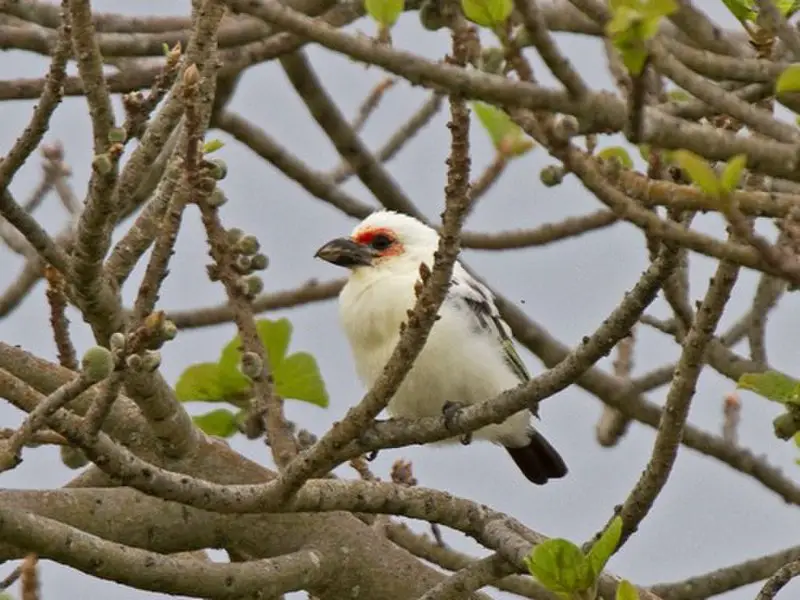
Chaplin’s barbet, also known as the Zambian barbet, is a bird species endemic to South Central Zambia. This species was named in honor of Sir Francis Drummond Percy Chaplin who served as colonial governor and serves as the only true endemic bird species for Zambia.
The Barbet belongs to family Lybiidae which until recently united with other barbets in Capitonidae. It has an overall green body colouration with yellow underparts and buff-coloured throat patch outlined by black malar stripe that extends from its cheeks down towards chest area which makes it stand out among others of its kind.
Its bill is large compared to size and slightly curved downwards at tip making it perfect for feeding on fruits and insects found within their habitat range.Scientific classification:
| Kingdom | Animalia |
| Phylum | Chordata |
| Class | Aves |
| Order | Piciformes |
| Family | Lybiidae |
| Genus | Lybius |
| Species | L. chaplini |
2. Southern Carmine Bee-Eater
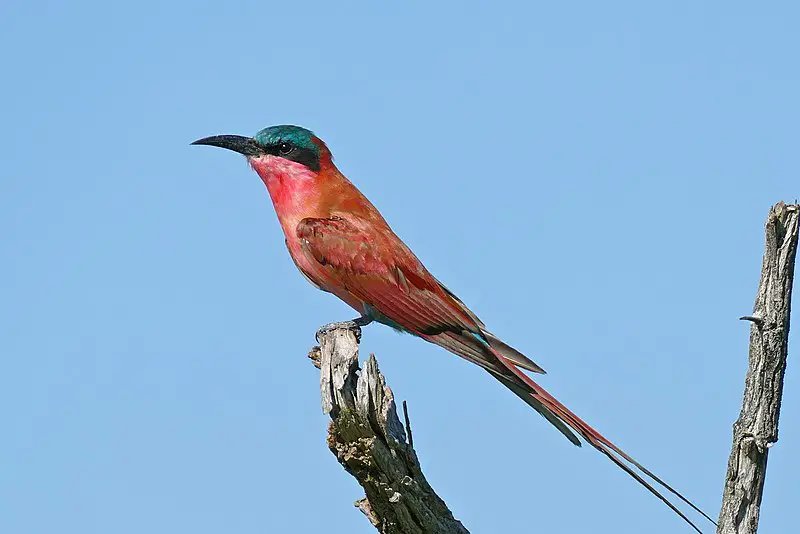
The Southern carmine bee-eater is a beautiful bird that can be found in subequatorial Africa. Its plumage is mainly carmine, but its crown and undertail are blue.
It ranges from KwaZulu-Natal and Namibia to Gabon, the eastern Democratic Republic of the Congo and Kenya.
This species feeds on insects like bees or wasps which it catches midair with acrobatic swoops while they’re flying by.
When not hunting for food these birds often gather together in large flocks before going off again to feed individually or as pairs.
They also roost communally at night near their regular feeding grounds so they can quickly return when dawn breaks.
The Southern carmine bee-eater plays an important role in controlling insect populations making them essential members of African ecosystems.Scientific classification:
| Kingdom | Animalia |
| Phylum | Chordata |
| Class | Aves |
| Order | Coraciiformes |
| Family | Meropidae |
| Genus | Merops |
| Species | M. nubicoides |
Also Featured In: Birds that You’ll Find in Kruger national park,
3. White-Fronted Bee-Eater
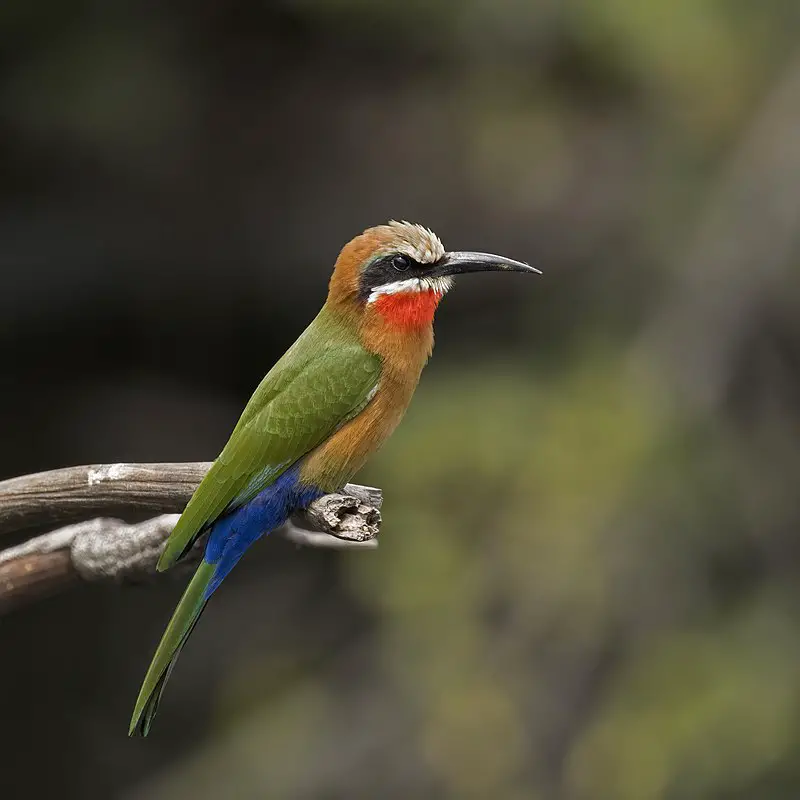
The White-fronted Bee-eater is a beautiful bird native to subequatorial Africa. It has an unmistakable white forehead, square tail and bright red throat patch that sets it apart from other species of bee eaters.
These birds typically nest in colonies by digging holes into cliffs or earthen banks near waterbodies.
During the day they can be seen perched on low trees waiting for passing insects which they swoop down upon with great agility to capture their prey midair.
They may also hover around flowers while searching for food – making them quite a sight to behold indeed.
All in all, these majestic creatures are truly fascinating to observe and make wonderful additions to any natural habitat.Scientific classification:
| Kingdom | Animalia |
| Phylum | Chordata |
| Class | Aves |
| Order | Coraciiformes |
| Family | Meropidae |
| Genus | Merops |
| Species | M. bullockoides |
4. Hamerkop
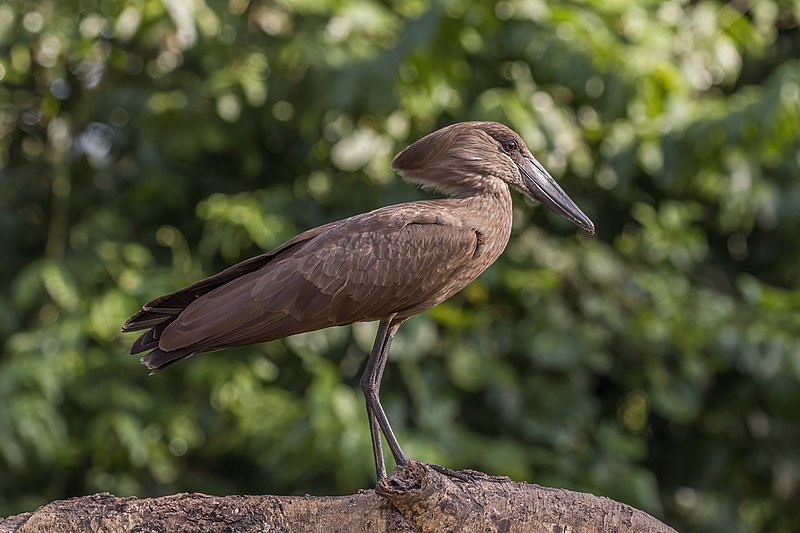
The Hamerkop is a unique wading bird found across sub-Saharan Africa and as far east as India.
It has an unmistakable silhouette, with its long bill topped by a crest at the back of its head that gives it the look of a hammerhead shark.
Its plumage consists mainly of browns and greys, providing excellent camouflage in reed beds.
The species was once classified alongside storks but is now believed to be closely related to pelicans and shoebills instead.
This medium-sized bird feeds on insects, fish, frogs or small reptiles which it captures from shallow water or plucks from trees near bodies of water.
Despite being considered ‘unlucky’ by some cultures due to superstition surrounding their appearance they are actually quite important for controlling populations of certain pests.Scientific classification:
| Kingdom | Animalia |
| Phylum | Chordata |
| Class | Aves |
| Order | Pelecaniformes |
| Family | Scopidae |
| Genus | Scopus |
| Species | S. umbretta |
5. Little Bee-Eater
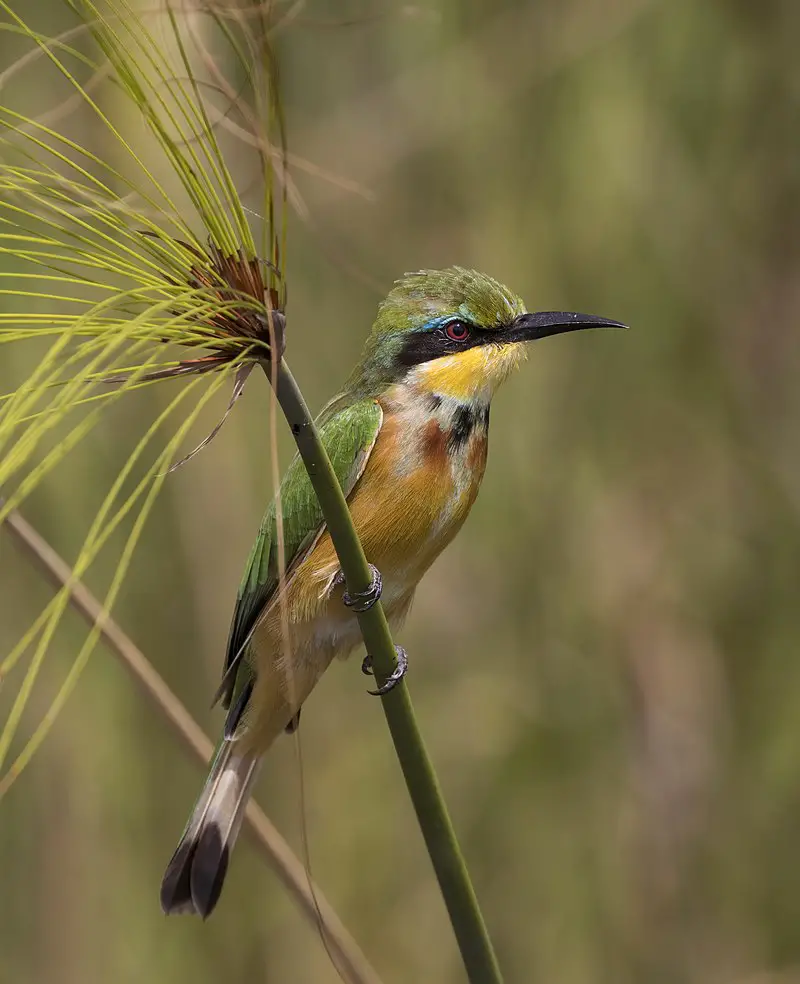
The Little Bee-eater (Merops pusillus) is a beautiful species of bird belonging to the family Meropidae.
These birds are found in much of Sub-Saharan Africa and their migration patterns depend on seasonal rainfall changes.
They have slender, brightly coloured bodies with an iridescent green sheen across the wings and back.
Their diet consists mainly of bees, wasps, dragonflies, moths and other insects which they catch mid-air or from perches above open grasslands or along mudbanks near water sources like rivers and lakes.
In order for these birds to digest their food properly before swallowing it whole, they use pebbles that help them grind up hard exoskeletons so as not to cause any blockages within their digestive tract – something only bee-eaters do.Scientific classification:
| Kingdom | Animalia |
| Phylum | Chordata |
| Class | Aves |
| Order | Coraciiformes |
| Family | Meropidae |
| Genus | Merops |
| Species | M. pusillus |
6. Verreaux’s Eagle-Owl
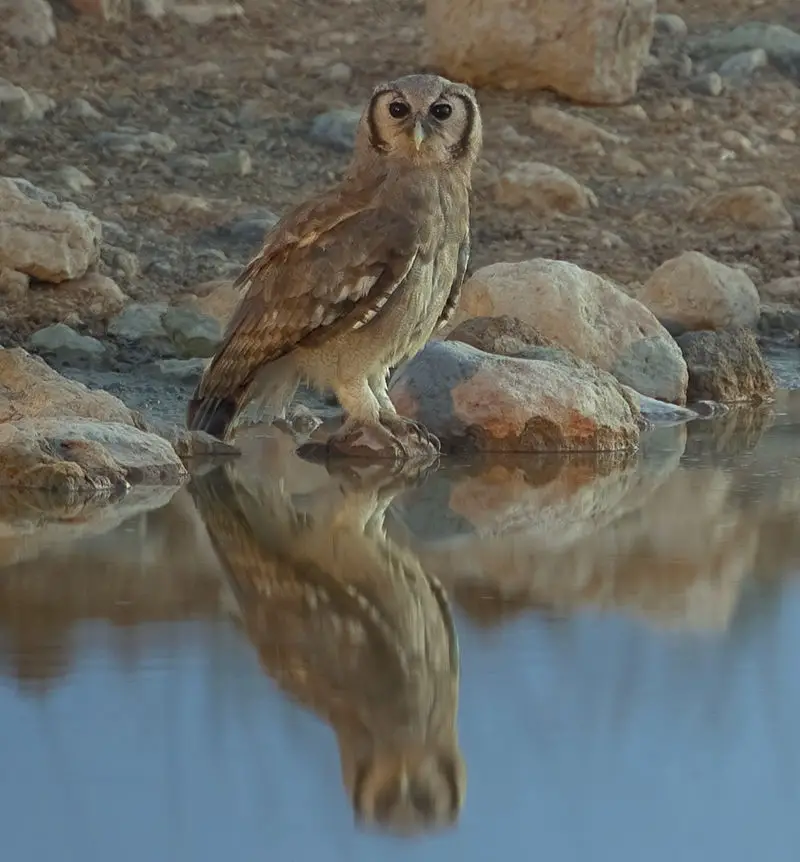
Verreaux’s eagle-owl is a magnificent bird that can be found in dry, wooded savannas of sub-Saharan Africa. It is the largest African owl and measures up to 66 cm (26 inches) long.
This majestic creature has grey plumage with white spots on its back and wings, while its face is covered by an impressive facial disk.
Its eyes are yellowish orange in color, surrounded by white feathers which give it a striking appearance.
These birds hunt mostly during the night but may occasionally also do so during daylight hours when food becomes scarce or if they have recently hatched young ones who need feeding.
Verreaux’s eagle-owls live alone or in pairs for much of the year until breeding season comes around after which two eggs will be laid at once and incubated for about 30 days before hatching into fluffy chicks.Scientific classification:
| Kingdom | Animalia |
| Phylum | Chordata |
| Class | Aves |
| Order | Strigiformes |
| Family | Strigidae |
| Genus | Bubo |
| Species | B. lacteus |
7. Böhm’s Bee-Eater
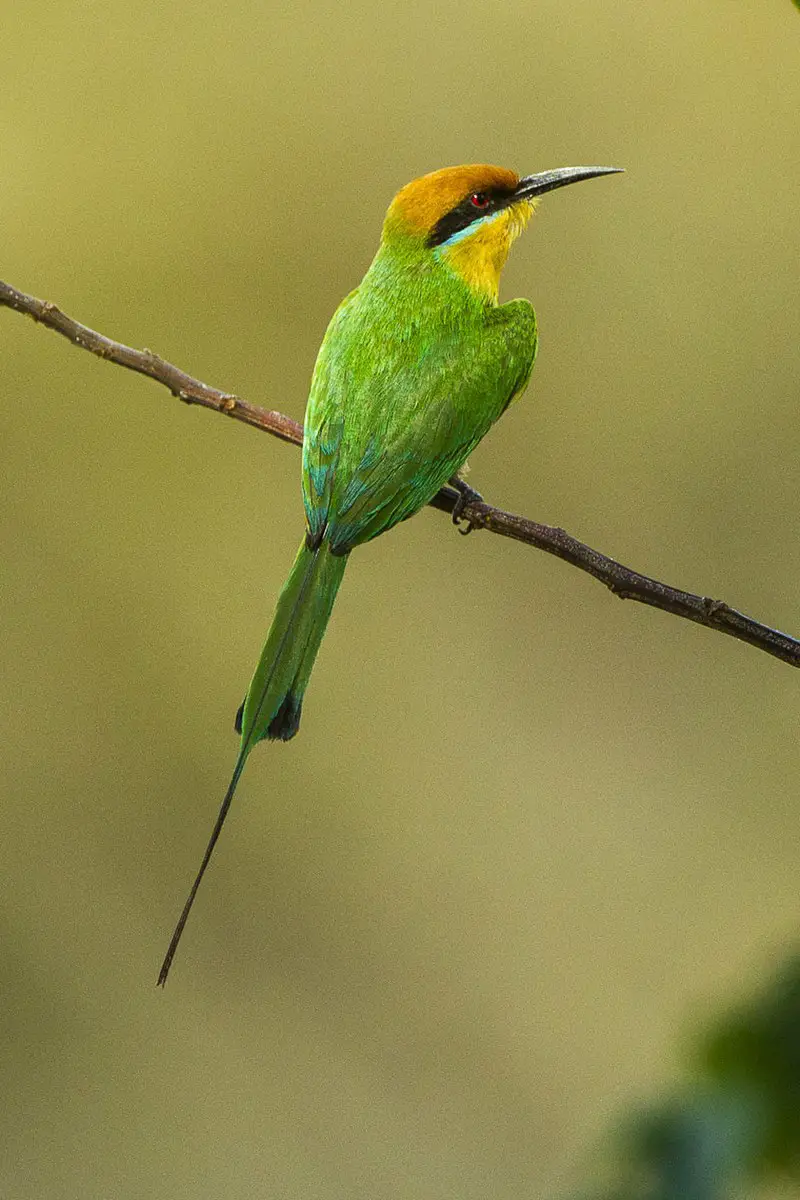
Böhm’s bee-eater is a type of bird found in the Democratic Republic of Congo, Malawi, Mozambique, Tanzania and Zambia. It belongs to the Meropidae family and was named after German zoologist Richard Böhm as a tribute for his scientific work.
These birds have bright plumage consisting mainly of shades of green with some black spots over their body and wings.
They build nests on banks near waterbodies such as rivers or lakes where they feed themselves by catching bees midair. Furthermore, these birds are also known to eat other insects like dragonflies, butterflies etc.
Moreover due to habitat loss caused by human activities there has been an alarming decline in the population size making them vulnerable according to IUCN red list assessment criteria.
Thus it becomes even more important that we take steps towards protecting this species from extinctionScientific classification:
| Kingdom | Animalia |
| Phylum | Chordata |
| Class | Aves |
| Order | Coraciiformes |
| Family | Meropidae |
| Genus | Merops |
| Species | M. boehmi |
8. African Jacana
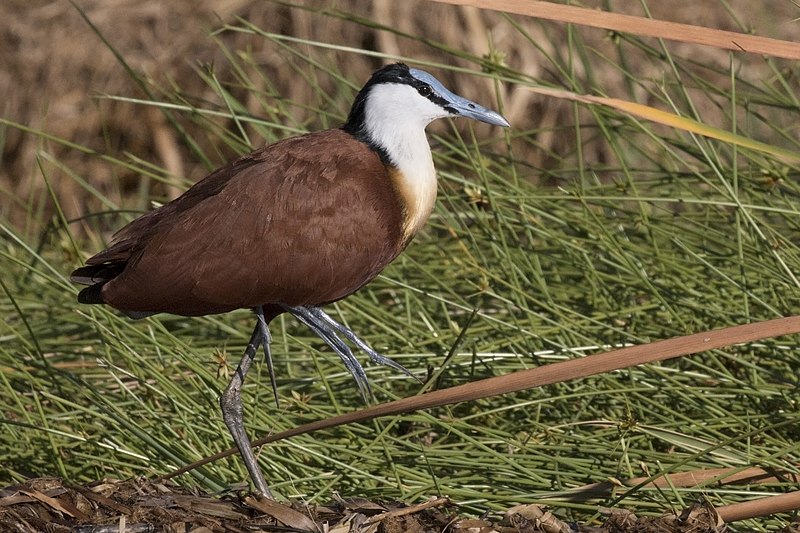
The African Jacana is a charming wader belonging to the family of Jacanidae, mostly found in sub-Saharan Africa.
It has long toes and claws that allow it to walk on floating vegetation in shallow lakes which form its preferred habitat.
The bird was officially described by Johann Friedri in 1789 with an interesting origin and pronunciation for its name -Jacanidae.
This aquatic bird is known for its striking plumage features like yellow crowns and black wings marked with chestnut brown stripes across them, making them look even more attractive when they spread their wing feathers during courtship displays.
They feed mainly on insects, tadpoles, frogs etc., skimming nearby water surface or plucking prey from vegetation as they wander around these wetlands areas.Scientific classification:
| Kingdom | Animalia |
| Phylum | Chordata |
| Class | Aves |
| Order | Charadriiformes |
| Family | Jacanidae |
| Genus | Actophilornis |
| Species | A. africanus |
9. Pel’s Fishing Owl
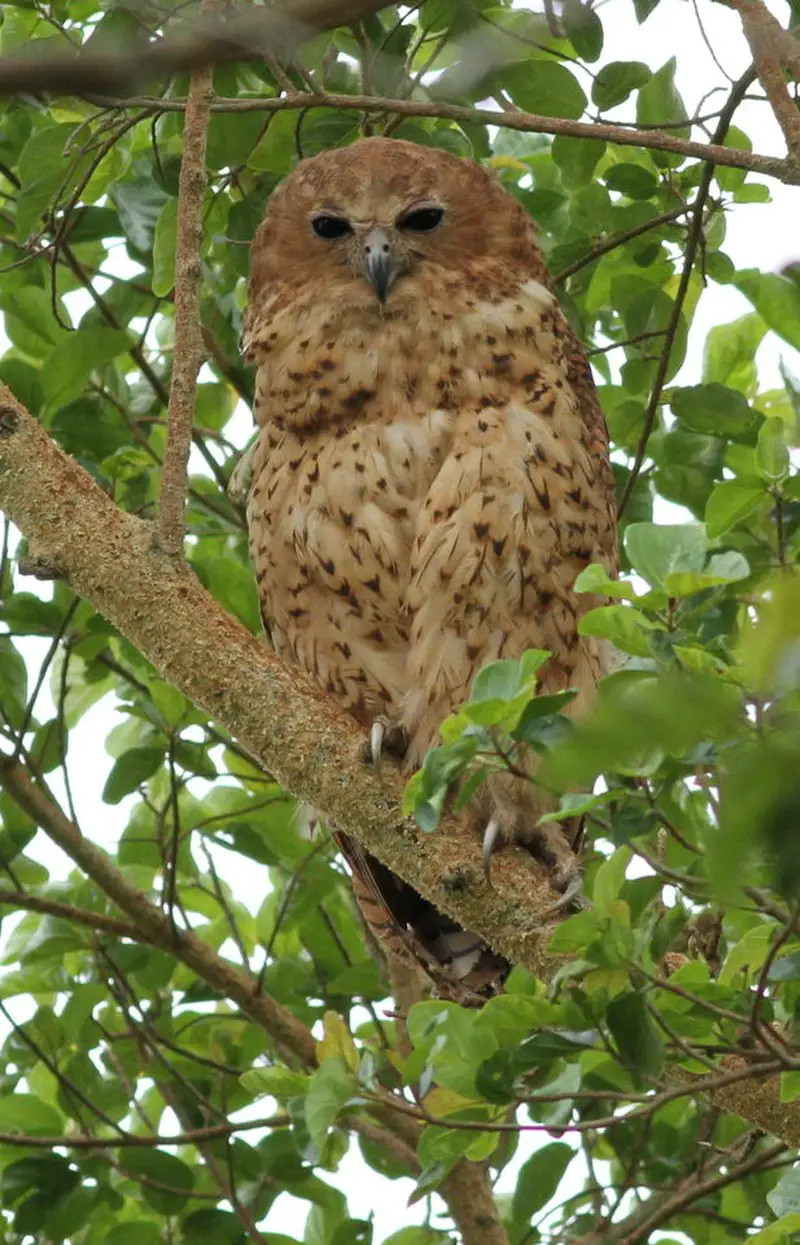
Pel’s fishing owl is a large species of Strigidae found in Africa. It hunts mainly at night, snatching up fish and frogs from rivers and lakes with its sharp talons.
They prefer slow-moving waterways with lots of overhanging trees so they can roost during the day or hunt for prey without being seen.
The owls nest in hollows or forks of large trees to stay safe from predators.
Even though there are many threats that put these birds at risk, conservation efforts have helped secure their population numbers for now.Scientific classification:
| Kingdom | Animalia |
| Phylum | Chordata |
| Class | Aves |
| Order | Strigiformes |
| Family | Strigidae |
| Genus | Scotopelia |
| Species | S. peli |
10. Chestnut-Headed Flufftail
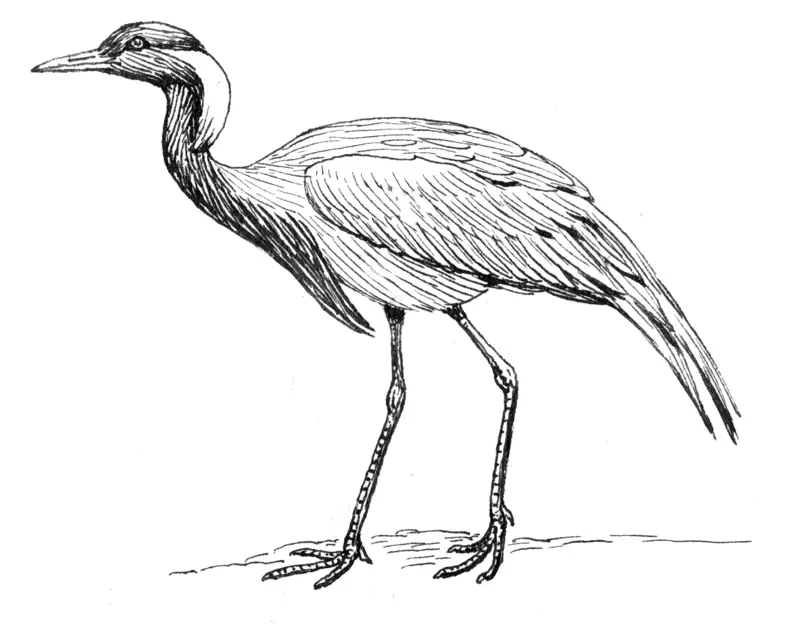
The Chestnut-headed flufftail is a species of bird belonging to the Sarothruridae family. Native to parts of Africa, it can be found in Angola, Cameroon, Democratic Republic of Congo, Gabon, Malawi Rwanda Tanzania and Zambia.
This small sized bird has an overall chestnut brown colouration with white patches on its face and underparts as well as barred wings. It feeds mainly on insects but sometimes also takes seeds or fruits from the ground or low vegetation cover such as grasses and shrubs.
Breeding usually happens during wet seasons when food availability is higher than usual; they nest in hollows made near water bodies like rivers and streams where they lay up to 3 eggs at a time which are incubated by both parents for about 17 days before hatching out into fluffy young chicks that fledge within 15 – 20 days after hatching .
Unfortunately due to habitat loss this species is listed as vulnerable by IUCN Red List Of Threatened SpeciesScientific classification:
| Kingdom | Animalia |
| Phylum | Chordata |
| Class | Aves |
| Order | Gruiformes |
| Family | Sarothruridae |
| Genus | Sarothrura |
| Species | S. lugens |
11. Marabou Stork
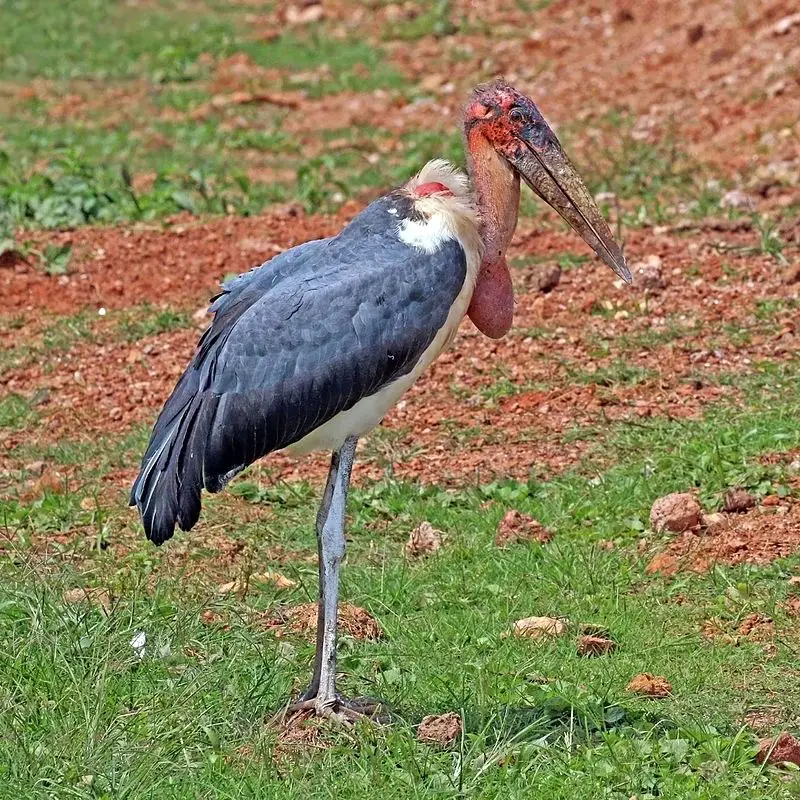
The marabou stork is a large wading bird native to sub-Saharan Africa. It has an unmistakable appearance, with cloak-like wings and back, skinny white legs and sometimes a large mass of “hair”.
They reside in both wet and arid habitats near human habitation, often found at landfill sites.
This species has earned the nickname ‘undertaker bird’ due to its unique shape viewed from behind.
Despite living alongside humans they remain elusive birds who rarely interact with us but can still be seen gliding on thermals or standing majestically by lakesides.
The marabou stork is truly an impressive sight that will stay in your memory forever.Scientific classification:
| Kingdom | Animalia |
| Phylum | Chordata |
| Class | Aves |
| Order | Ciconiiformes |
| Family | Ciconiidae |
| Genus | Leptoptilos |
| Species | L. crumenifer |
12. Square-Tailed Nightjar
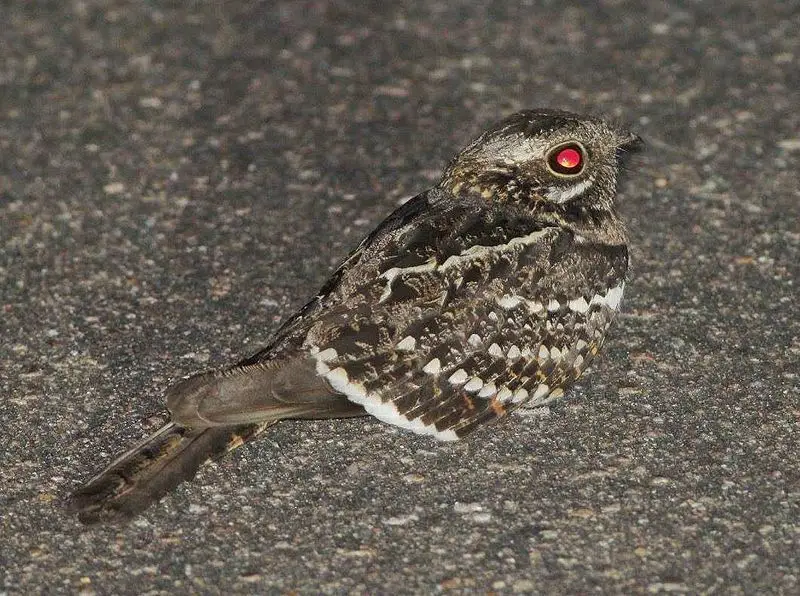
The Square-tailed nightjar is a species of nocturnal bird found in the tropical and subtropical woodlands of Afrotropics. It has an extensive range south of the African equator, making it one of the most widespread members of its genus.
The square-tail name comes from its distinguishing field mark – a slightly squared off tail tip compared to similar birds such as Slender-tailed Nightjars which inhabit dry bush country areas.
Square tailed nightjars have dark greyish brown upperparts with lighter underparts that are heavily barred with black across the chest and belly; their wings also feature white barring on them too.
They feed mainly on moths, beetles and other flying insects at dusk or during moonlit nights by snatching them out midair using their long beaks and talons for extra grip when catching prey.Scientific classification:
| Kingdom | Animalia |
| Phylum | Chordata |
| Class | Aves |
| Order | Caprimulgiformes |
| Family | Caprimulgidae |
| Genus | Caprimulgus |
| Species | C. fossii |
13. Emerald-Spotted Wood Dove
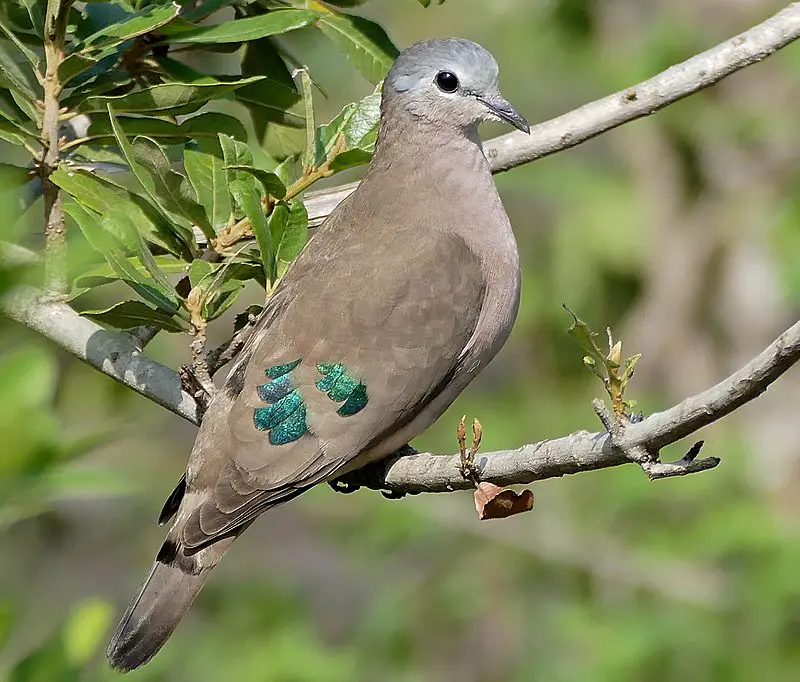
The Emerald-spotted Wood Dove is an incredible bird native to eastern and southern Africa. It has a unique plumage, with its back, hindneck, wings and tail being pale grey brown in color while its breast and belly are creamy white.
The most distinguishing feature of this dove however is the bright emerald spots on both sides of its neck which distinguishes it from other doves.
This small plump pigeon typically measures around 20 cm in length and can be found inhabiting open drier deciduous woodland or second growth areas but never evergreen rainforests or semi-deserts as these habitats lack suitable food sources for them to survive upon.
They feed primarily off fruits found within their natural environments such as wild figs, guavas etc., making them important seed dispersers for many plant species across their range.Scientific classification:
| Kingdom | Animalia |
| Phylum | Chordata |
| Class | Aves |
| Order | Columbiformes |
| Family | Columbidae |
| Genus | Turtur |
| Species | T. chalcospilos |
14. Water Thick-Knee
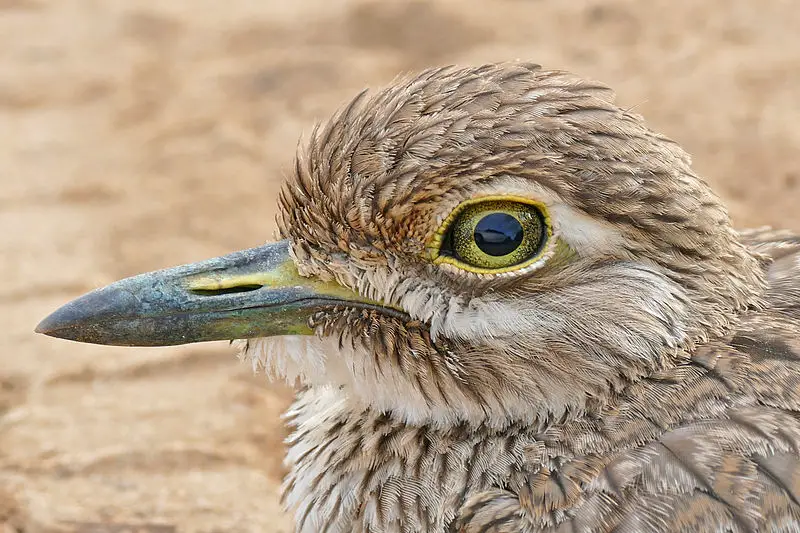
The Water thick-knee is a species of bird belonging to the Burhinidae family. It has a wide distribution in sub-Saharan Africa, where it can be found near waterbodies such as rivers, lakes and wetlands.
Its plumage is dark brown above with white spots on its wings, while below it is mostly greyish or whitish.
The bill is long and straight with yellow legs and feet. During breeding season they are more vocal than usual making loud calls during the night time hours that sound like “keh keh”.
This bird feeds mainly on insects but also takes small reptiles, crustaceans and molluscs from shallow waters when available.
Breeding pairs construct scrapes within grassy areas which they use for nesting sites during the dry season months between July to September depending on locationScientific classification:
| Kingdom | Animalia |
| Phylum | Chordata |
| Class | Aves |
| Order | Charadriiformes |
| Family | Burhinidae |
| Genus | Burhinus |
| Species | B. vermiculatus |
15. Black-Cheeked Lovebird
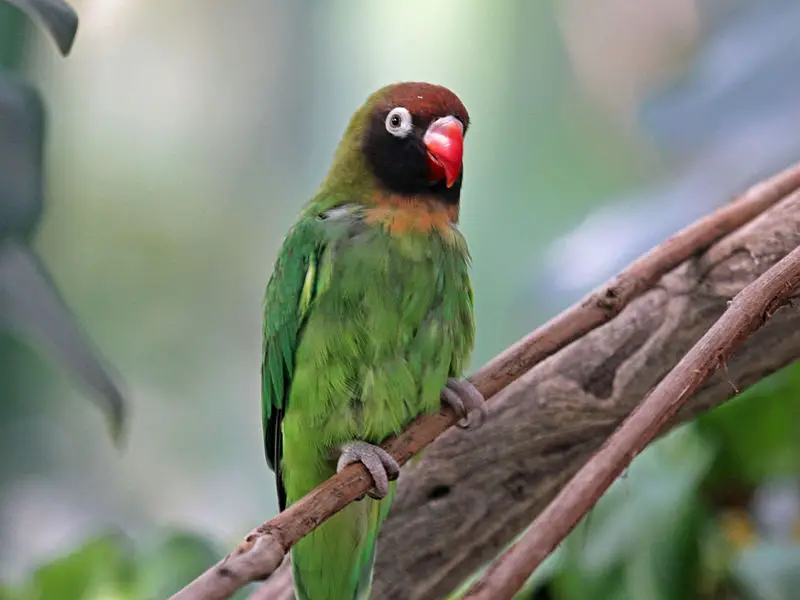
The black-cheeked lovebird is a beautiful, small parrot species with predominantly green feathers and a brown head. It stands out from other members of the lovebird genus due to its red beak and white eye rings.
This bird is endemic to southwest Zambia where it faces threats from habitat loss as well as illegal trapping for the pet trade industry.
Despite being monotypic in nature, there has been speculation that this species may actually be related or even identical to Lilian’s Lovebird which inhabits nearby regions.
As conservation efforts are critical for their existence, people should do what they can to protect these amazing birds and ensure that future generations will have an opportunity to appreciate them too.Scientific classification:
| Kingdom | Animalia |
| Phylum | Chordata |
| Class | Aves |
| Order | Psittaciformes |
| Family | Psittaculidae |
| Genus | Agapornis |
| Species | A. nigrigenis |
16. Senegal Coucal
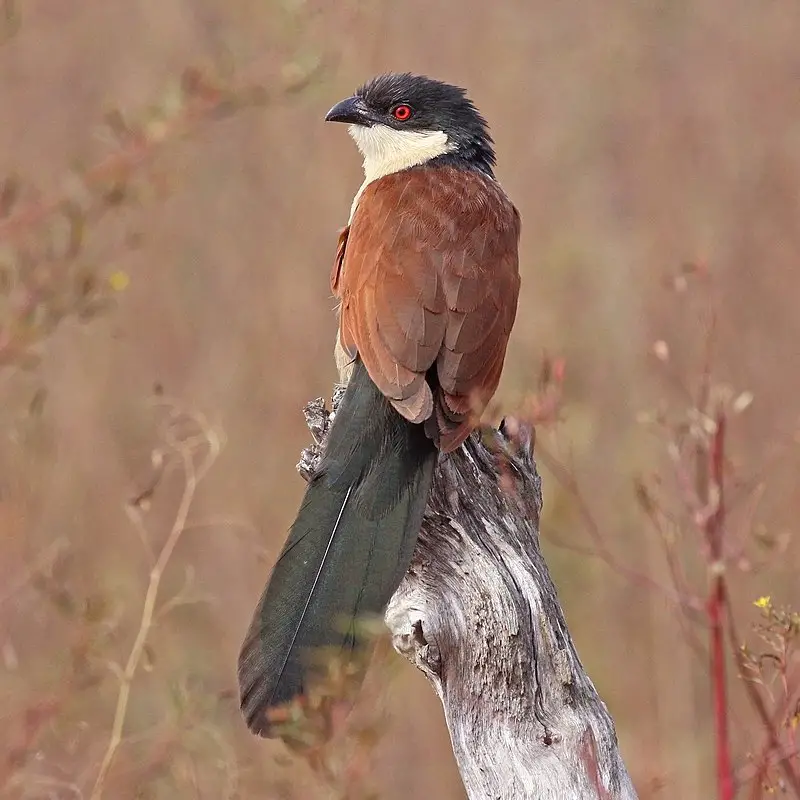
The Senegal coucal is a cuckoo-like bird native to Central and Southern Africa. It has a medium-sized body with black wings, tail and head along with white breast feathers.
Its natural habitat consists of lightly wooded savannahs where it feeds on insects, small reptiles, amphibians and fruits.
This species can be found in pairs or alone atop low bushes searching for prey or perched up high singing its distinctive song that features a mix of harsh notes as well as melodic ones.
The Senegal coucal enjoys the sun’s rays but also loves sheltering in dense vegetation when danger arises nearby.
Overall this beautiful bird makes an interesting addition to any backyard garden.Scientific classification:
| Kingdom | Animalia |
| Phylum | Chordata |
| Class | Aves |
| Order | Cuculiformes |
| Family | Cuculidae |
| Genus | Centropus |
| Species | C. senegalensis |
17. White-Browed Coucal
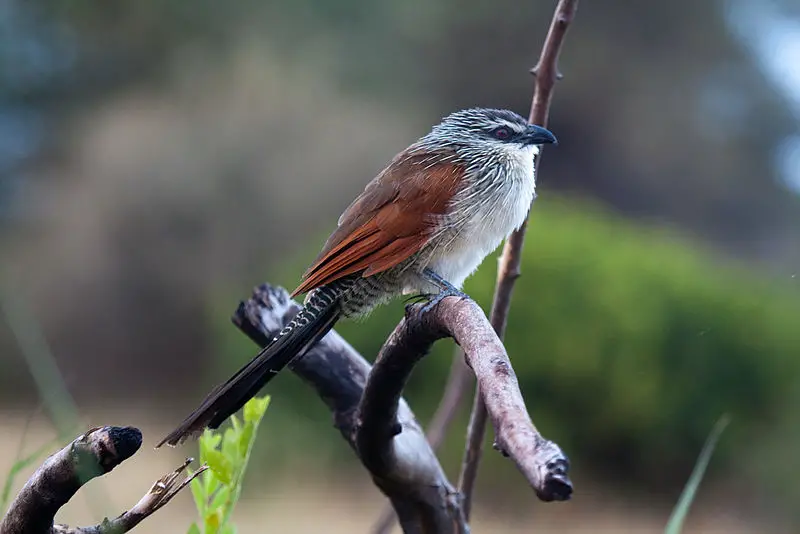
The White-browed Coucal is a species of bird belonging to the Cuculidae family. It can be found in sub-Saharan Africa, inhabiting thick vegetation and rank undergrowth as well as coastal regions.
This medium-sized cuckoo has a length between 36 and 42 cm and is sometimes considered a subspecies of Burchell’s coucal.
Its main distinguishing feature is its white eyebrow which extends towards the back of its head, giving it an elegant look that makes it stand out from other birds in its habitat.
Additionally, this species also features black plumage with some yellow spots on their wings and tail feathers for extra beauty points.
All in all, these fascinating creatures make great additions to any wildlife enthusiast’s list of spotted animals.Scientific classification:
| Kingdom | Animalia |
| Phylum | Chordata |
| Class | Aves |
| Order | Cuculiformes |
| Family | Cuculidae |
| Genus | Centropus |
| Species | C. superciliosus |
18. Pearl-Spotted Owlet
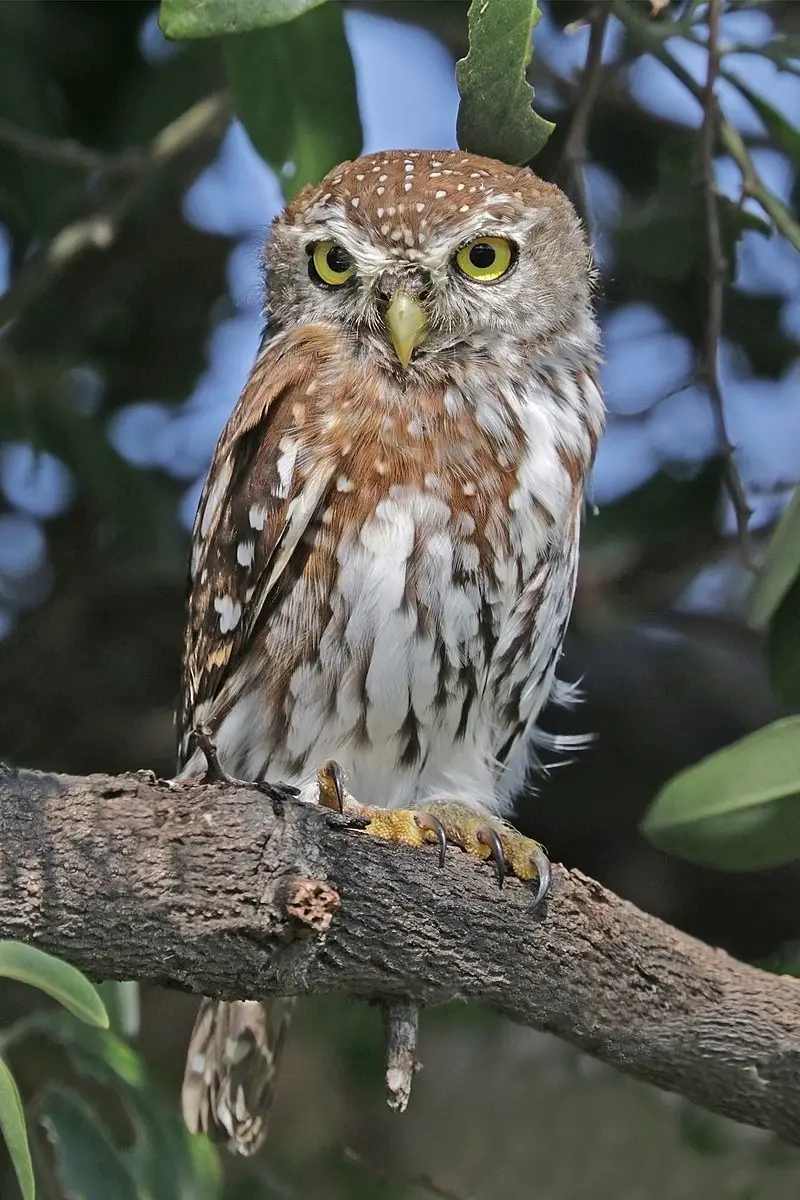
The Pearl-spotted Owlet is a small bird of prey that lives in sub-Saharan Africa. It belongs to the Strigidae family, which are commonly referred to as typical owls or true owls.
These birds have brown feathers with heavy spots, making them easily recognizable among other species of owl.
They usually measure between 14 and 16 centimeters long with an average wingspan of 28 centimeters wide.
Their diet consists mainly of insects such as moths and beetles but they also feed on frogs and small rodents occasionally.
During mating season males will use their sharp call for territorial purposes while females remain silent during this time period.
The female lays 2-4 eggs at one time before incubating them for around 3 weeks until hatching occurs after which both parents take part in feeding their young chicks until fledging age which is when they become independent enough to survive on their own in nature.Scientific classification:
| Kingdom | Animalia |
| Phylum | Chordata |
| Class | Aves |
| Order | Strigiformes |
| Family | Strigidae |
| Genus | Glaucidium |
| Species | G. perlatum |
19. Malachite Kingfisher
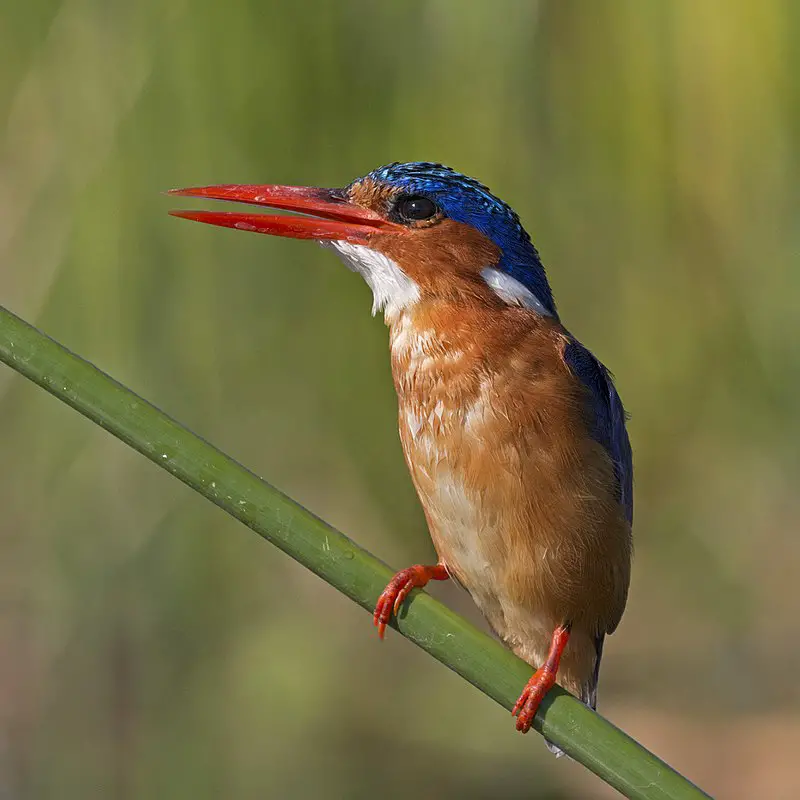
The Malachite Kingfisher is a beautiful bird found in Africa south of the Sahara. It has bright blue wings and tail, with greenish-black upperparts, white chin and breast and orange lower belly.
The species was first described by German naturalist Peter Simon Pallas in 1764 who gave it its binomial name “Alcedo cristata”.
This kingfisher typically inhabits rivers where it feeds on fish, frogs as well as aquatic invertebrates like crustaceans and insects.
Although mainly resident throughout the year, some do make seasonal movements due to climate changes.
These birds are monogamous during breeding season which usually lasts from August till October when they build their nests inside river banks or overhanging vegetation near water bodies.Scientific classification:
| Kingdom | Animalia |
| Phylum | Chordata |
| Class | Aves |
| Order | Coraciiformes |
| Family | Alcedinidae |
| Subfamily | Alcedininae |
| Genus | Corythornis |
| Species | C. cristatus |
20. Purple-Crested Turaco
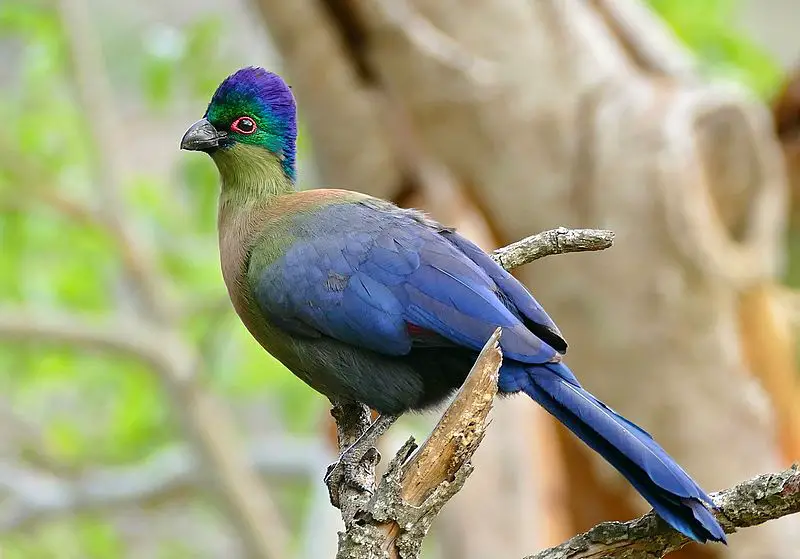
The Purple-crested turaco is a beautiful bird found in African countries like South Africa. It has striking plumage, with its head and crest being bright purple or blue-ish green.
Its wings, back, and tail are black while the underside of its body is white to cream colored. The bill of this species is yellow and it also has red eyes which stand out against its feathers.
This species prefers woodlands and habitats near streams or rivers where they can find plenty of food such as fruit, leaves, buds and nectar from flowers.
They often congregate in flocks when looking for food either on high branches or close to ground level within their habitat range areas across southern Africa’s woodland regions making them easily visible by observers whilst searching for these feathered beauties.Scientific classification:
| Kingdom | Animalia |
| Phylum | Chordata |
| Class | Aves |
| Order | Musophagiformes |
| Family | Musophagidae |
| Genus | Gallirex |
| Species | G. porphyreolophus |
21. Grey Go-Away-Bird
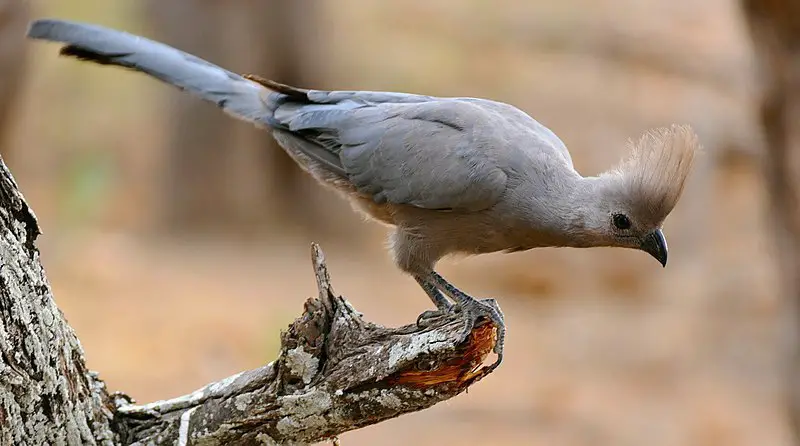
The Grey Go-Away-Bird is a beautiful and vibrant bird native to the southern Afrotropics. It has grey feathers on its body with white edging, making it distinct from other birds in its area.
These bold birds can be seen foraging for food high up in trees or dust bathing on the ground in groups or parties.
When disturbed they make their presence known by producing loud cackling calls that sound like “go away”.
This species of bird prefers arid to moist open woodlands and thorn savanna near surface water which provides them with plenty of opportunities to search for food such as insects and fruits.
All in all, the Grey Go-Away-Bird is an interesting member of the avian community.Scientific classification:
| Kingdom | Animalia |
| Phylum | Chordata |
| Class | Aves |
| Order | Musophagiformes |
| Family | Musophagidae |
| Genus | Corythaixoides |
| Species | C. concolor |
22. Red-Billed Oxpecker
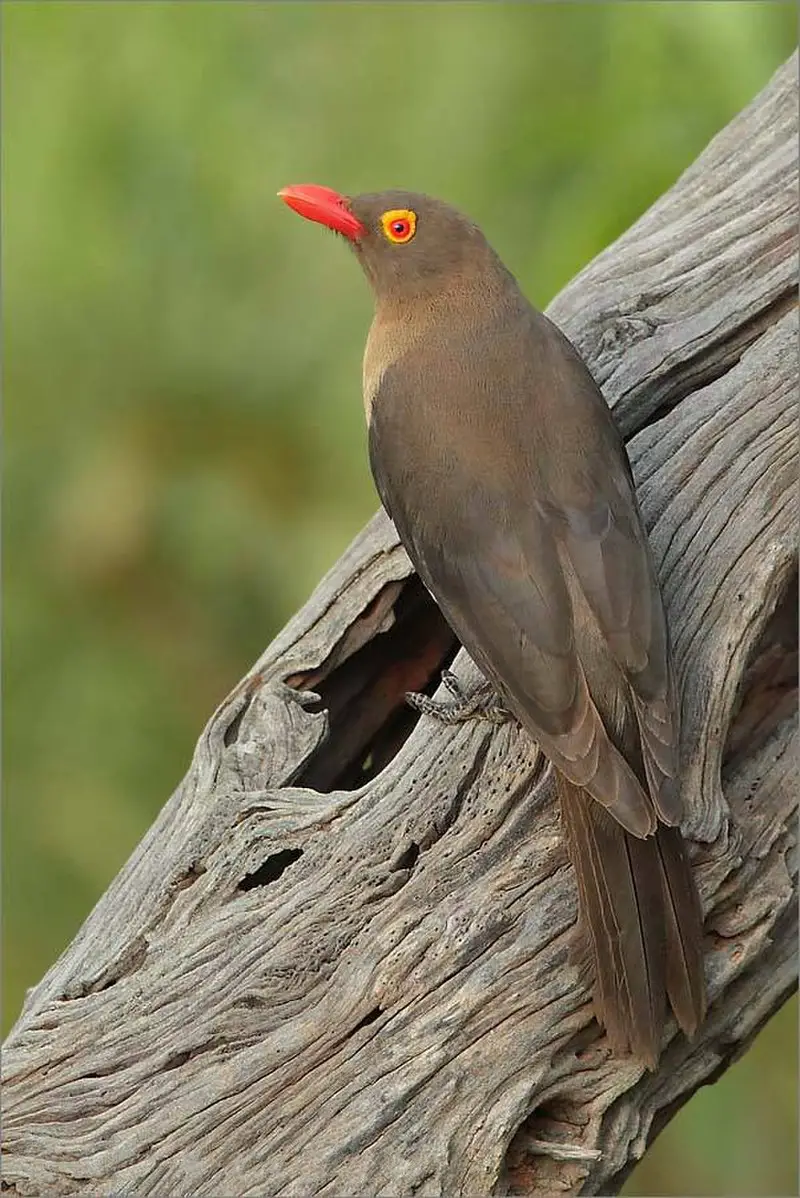
The red-billed oxpecker is a vibrant bird native to the savannas of sub-Saharan Africa. It has bright chestnut plumage, with distinctive yellow and black markings on its wings and tail.
The beak is a deep crimson color, for which it gets its name. These birds live in small flocks that often roost together at night or feed near large herds of animals such as zebra or wildebeest during the day.
They mainly eat ticks off these larger mammals but will also take advantage of any other food sources they can find such as fruits or insects.
Red-billed oxpeckers are known to have an important relationship with their prey; by removing parasites from them they help prevent diseases from spreading amongst different species in the area.Scientific classification:
| Kingdom | Animalia |
| Phylum | Chordata |
| Class | Aves |
| Order | Passeriformes |
| Family | Buphagidae |
| Genus | Buphagus |
| Species | B. erythrorynchus |
Also Featured In: Savanna Birds You Need to See, Birds that Ngorongoro Crater
23. Blacksmith Lapwing
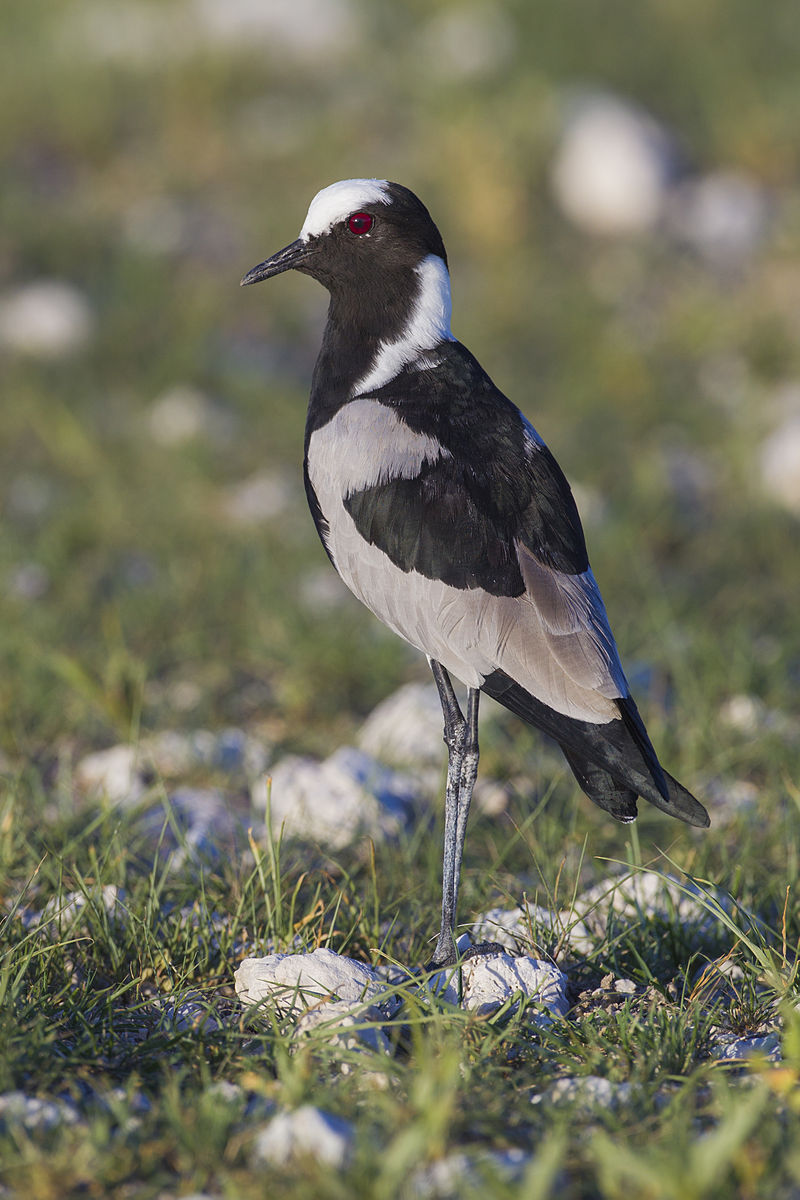
The Blacksmith lapwing is a bird that has an unique appearance with black, grey and white colors. It can be found in Kenya through central Tanzania to south Africa.
The name of the species comes from its alarm call which resembles the sound of a blacksmith striking an anvil – “tink, tink, tink.”.
These birds are quite common but their numbers have been declining due to habitat destruction caused by human activities such as urbanization and agriculture expansion.
They build nests on open ground like grasslands or scrubland near water sources where they feed on insects and small invertebrates while also being preyed upon by larger animals like mongooses or snakes.
Conservation efforts must be taken in order protect these beautiful creatures so future generations can admire them too.Scientific classification:
| Kingdom | Animalia |
| Phylum | Chordata |
| Class | Aves |
| Order | Charadriiformes |
| Family | Charadriidae |
| Genus | Vanellus |
| Species | V. armatus |
24. Brown-Hooded Kingfisher
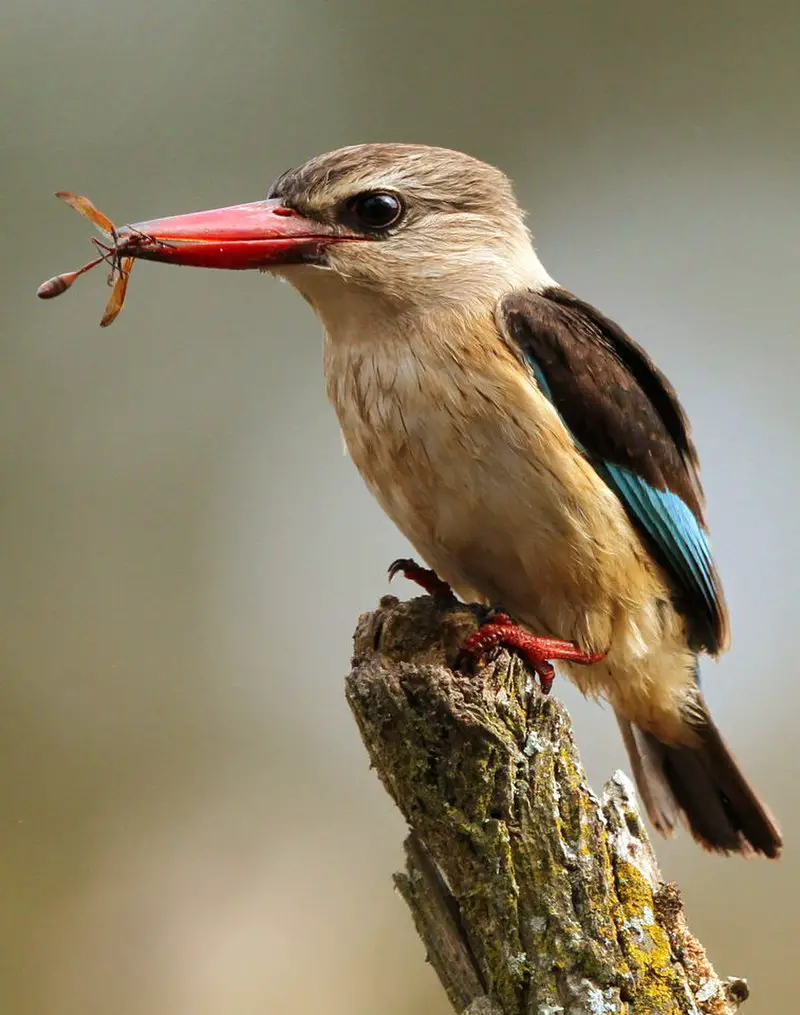
The Brown-hooded kingfisher is a species of bird found in Sub-Saharan Africa. It has a brown head and blackish, turquoise wings which makes it quite distinguishable among other types of birds.
They prefer to live near woodlands, scrubland, forest edges and even suburban areas so they can easily find food sources such as beetles, grasshoppers or small lizards that make up their diet.
The International Union for Conservation of Nature (IUCN) considers the Brown-hooded Kingfisher as being of least concern due to its wide distribution range and abundance across many regions throughout Africa.Scientific classification:
| Kingdom | Animalia |
| Phylum | Chordata |
| Class | Aves |
| Order | Coraciiformes |
| Family | Alcedinidae |
| Subfamily | Halcyoninae |
| Genus | Halcyon |
| Species | H. albiventris |
25. Swainson’s Spurfowl
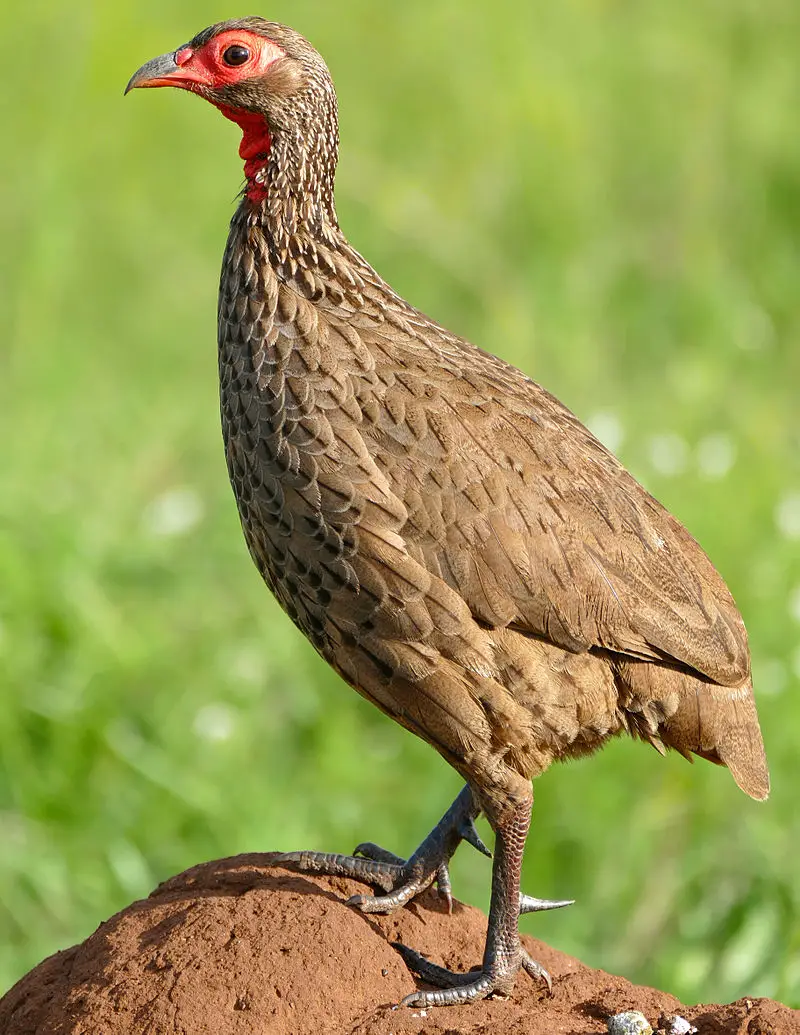
Swainson’s spurfowl, a species of bird in the family Phasianidae, can be found throughout Southern Africa. It is easily recognized by it beautiful plumage which includes blackish-brown body feathers and white throat patches.
The male also has an orange patch on its head. This majestic bird is quite popular amongst outdoor enthusiasts as they consider it to be a culinary delicacy when hunted with care and respect for the animal itself. Swainson’s spufowls are highly social creatures that often gather in flocks to feed or breed during certain seasons of the year.
They primarily eat seeds and insects but have been known at times to consume small reptiles such as lizards too. Although their diet varies seasonally depending upon availability, these birds remain resilient against changing climates thanks to their adaptability and strong conservation measures taken by government agencies across various countries in Southern Africa where this beauty resides.Scientific classification:
| Kingdom | Animalia |
| Phylum | Chordata |
| Class | Aves |
| Order | Galliformes |
| Family | Phasianidae |
| Genus | Pternistis |
| Species | P. swainsonii |
26. Woodland Kingfisher
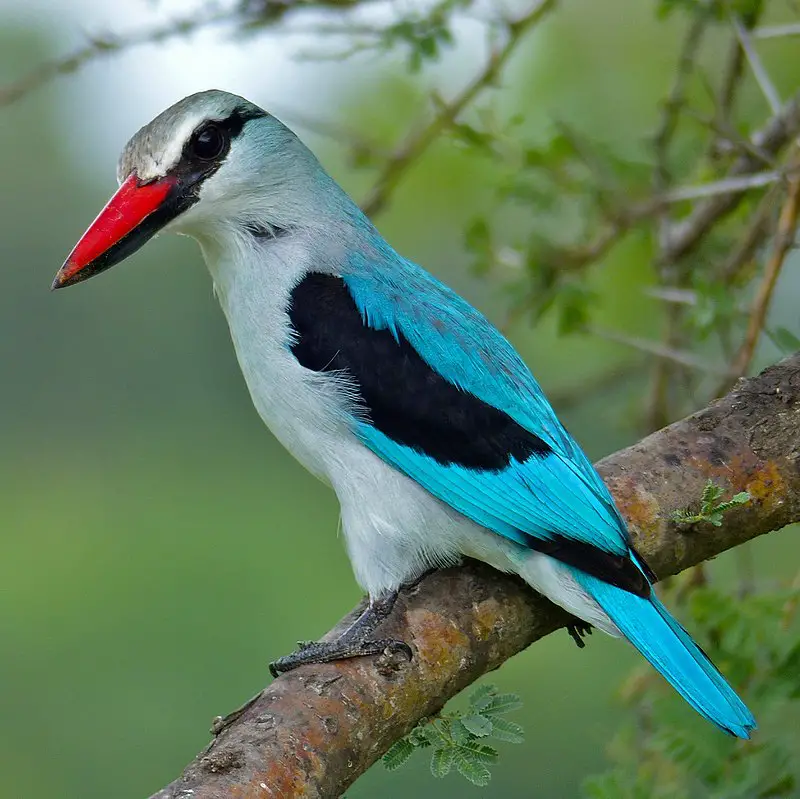
The Woodland Kingfisher is a beautiful bird, native to Africa south of the Sahara. It was first described in 1766 by Carl Linnaeus who called it Alcedo senegalensis.
This tree kingfisher has an attractive blue and white plumage with some red and black markings on its wings, tail and head.
The male also has a bright orange beak which helps to distinguish him from the female whose beak is yellowish-green.
These birds can usually be found in wooded areas near water sources such as rivers or lakes where they hunt for food including fish, frogs, small insects and even lizards.
They build their nests either high up in trees or inside holes dug out of banks near rivers and ponds.
Although not threatened yet, these lovely creatures need our protection so that future generations will have the chance to marvel at them too.Scientific classification:
| Kingdom | Animalia |
| Phylum | Chordata |
| Class | Aves |
| Order | Coraciiformes |
| Family | Alcedinidae |
| Subfamily | Halcyoninae |
| Genus | Halcyon |
| Species | H. senegalensis |
27. Giant Kingfisher
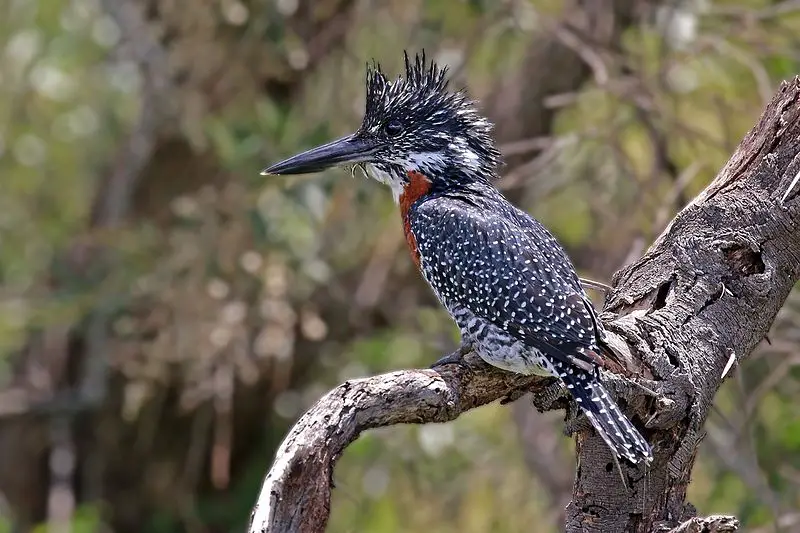
The Giant Kingfisher is the biggest of its kind in Africa, living and breeding over most parts of the continent excluding arid southwest regions.
It was first formally described by German naturalist Peter Simon Pallas back in 1769 under Alcedo maxima as its binomial name.
Subsequently, it has been placed into a new genus Megaceryle which was named by French ornithologist Louis Jean Pierre Vieillot in 1816.
This majestic bird typically measures about 40 cm (15 inches) long with predominantly blue-green plumage on top combined with white breast and belly underneath.
Its bill is large, robust and bright red or orange coloured adding to its striking beauty even further.Scientific classification:
| Kingdom | Animalia |
| Phylum | Chordata |
| Class | Aves |
| Order | Coraciiformes |
| Family | Alcedinidae |
| Subfamily | Cerylinae |
| Genus | Megaceryle |
| Species | M. maxima |
Also Featured In: Big Birds that Live in Uganda, Large Birds of Uganda
28. Black-And-Rufous Swallow
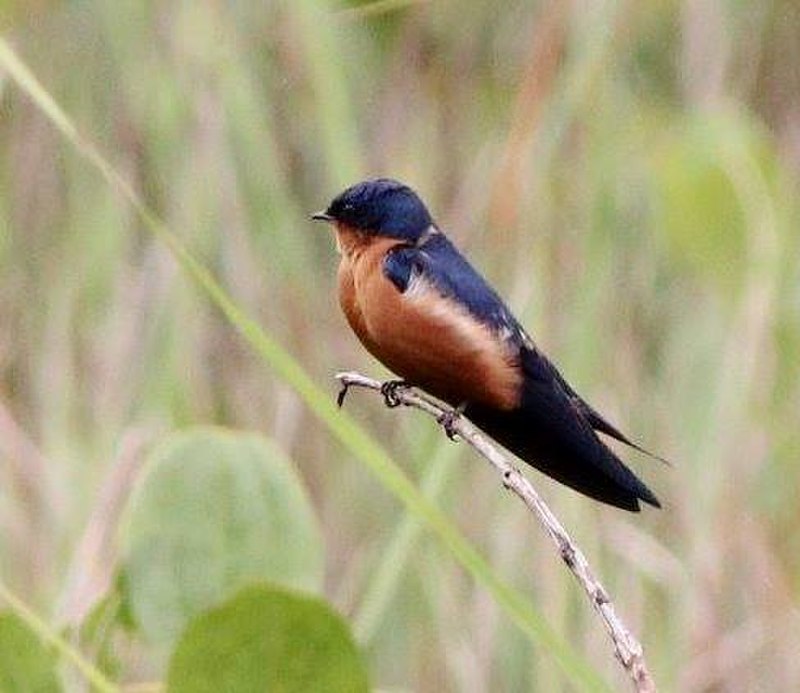
The black-and-rufous swallow is a species of bird in the Hirundinidae family. It can be found inhabiting miombo ecosystems in Angola, Democratic Republic of Congo and Zambia.
This small but beautiful creature has an unmistakable colouration – rufous on its back with glossy black wings and tail feathers that shimmer like oil when it catches light from the sun.
Its diet consists mainly of flying insects which it captures midair during its high speed flights over open country or woodland habitats.
It nests among rocks as well as tree hollows, laying up to 3 eggs at a time before incubating them for about two weeks until they hatch into fluffy chicks ready to explore their new world.Scientific classification:
| Kingdom | Animalia |
| Phylum | Chordata |
| Class | Aves |
| Order | Passeriformes |
| Family | Hirundinidae |
| Genus | Hirundo |
| Species | H. nigrorufa |
29. Denham’s Bustard
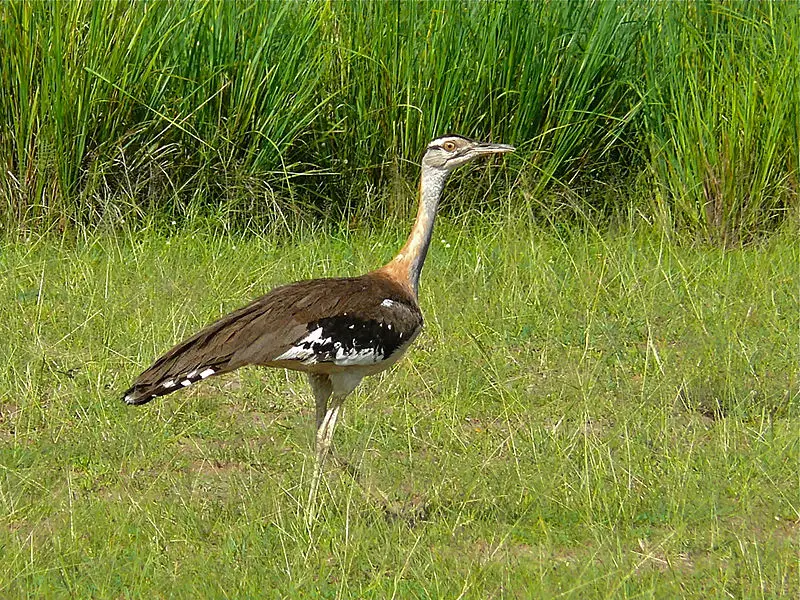
Denham’s bustard is a large bird belonging to the Bustard family found in Sub-Saharan Africa. It inhabits open ground including agricultural land, grassland and floodplains.
This species is resident but some inland populations move down south during winter season for better climate conditions.
The common names used for this species are dedicated to an English explorer called Stanley who first discovered it in 1841 while travelling across Central African Republic region.
Denham’s bustards have strong legs which help them take off quickly from the ground due to their heavy body weight of 2–3 kgs on average with wingspan ranging up till 140 cm long.
They feed mostly upon insects, rodents and seeds making them omnivorous birds.
These birds usually live solitary lives or forms small flocks when migrating but come together during breeding seasons as they build their nests close by each other and mate around same time period too.Scientific classification:
| Kingdom | Animalia |
| Phylum | Chordata |
| Class | Aves |
| Order | Otidiformes |
| Family | Otididae |
| Genus | Neotis |
| Species | N. denhami |
30. Anchieta’s Sunbird
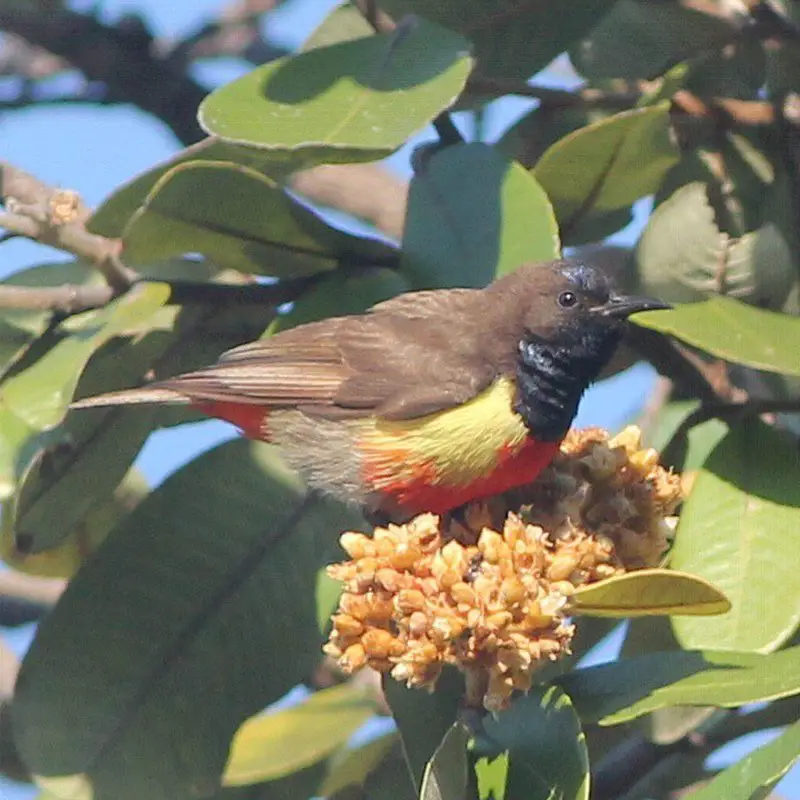
Anchieta’s sunbird is a beautiful species of bird from the family Nectariniidae found in several parts of Africa. It has an iridescent plumage, with green and golden feathers on its upperparts and yellowish-green ones below.
Its head is grey while its throat is bright yellow. This species was named after José Alberto de Oliveira Anchieta, who studied birds in Angola during the 19th century. The diet of this small songbird consists mostly of nectar taken from flowers, as well as some insects to supplement it nutritionally.
They are solitary feeders but may form flocks when looking for food or sheltering during harsh weather conditions like heavy rains or strong winds.
These tiny birds can be seen perched atop trees searching for food or singing their melodious songs – usually early in the morning – which makes them a delight to watch.Scientific classification:
| Kingdom | Animalia |
| Phylum | Chordata |
| Class | Aves |
| Order | Passeriformes |
| Family | Nectariniidae |
| Genus | Anthreptes |
| Species | A. anchietae |
31. White-Crowned Lapwing
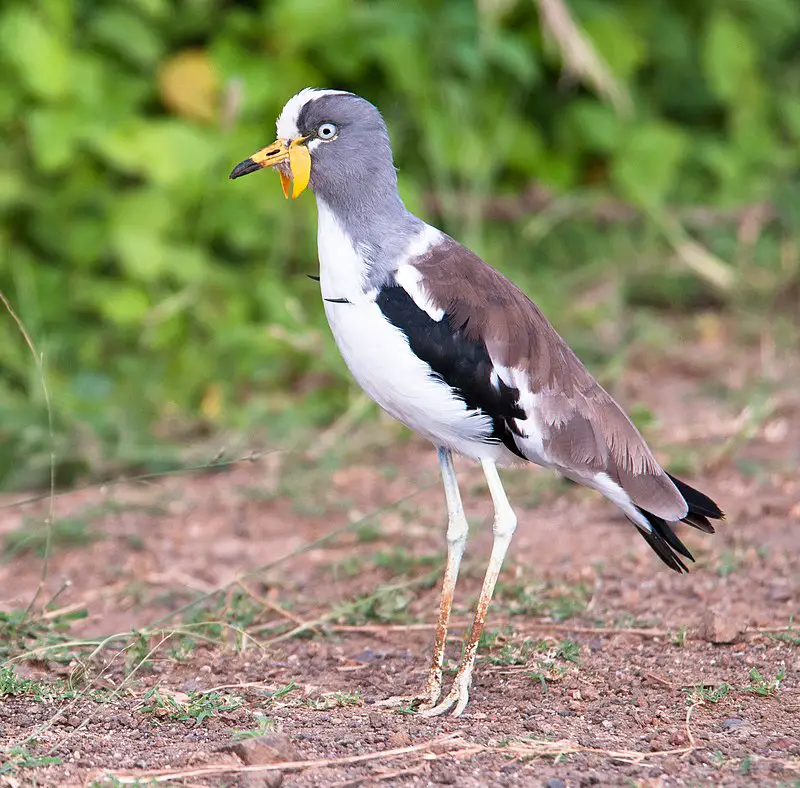
The White-crowned Lapwing is a medium sized wader found in tropical Africa near large rivers. It has distinctively patterned wings and tail with black, white, brown and grey markings on the head making it unmistakable from other lapwings.
Its crown of feathers gives this bird its name as well as adding to its unique look. This bird stands out due to its vibrant plumage which sets it apart from any other species living in the same habitat.
The White-crowned Lapwing is an impressive sight that will be sure to draw attention amongst wildlife watchers lucky enough to see one.Scientific classification:
| Kingdom | Animalia |
| Phylum | Chordata |
| Class | Aves |
| Order | Charadriiformes |
| Family | Charadriidae |
| Genus | Vanellus |
| Species | V. albiceps |
32. Bar-Winged Weaver
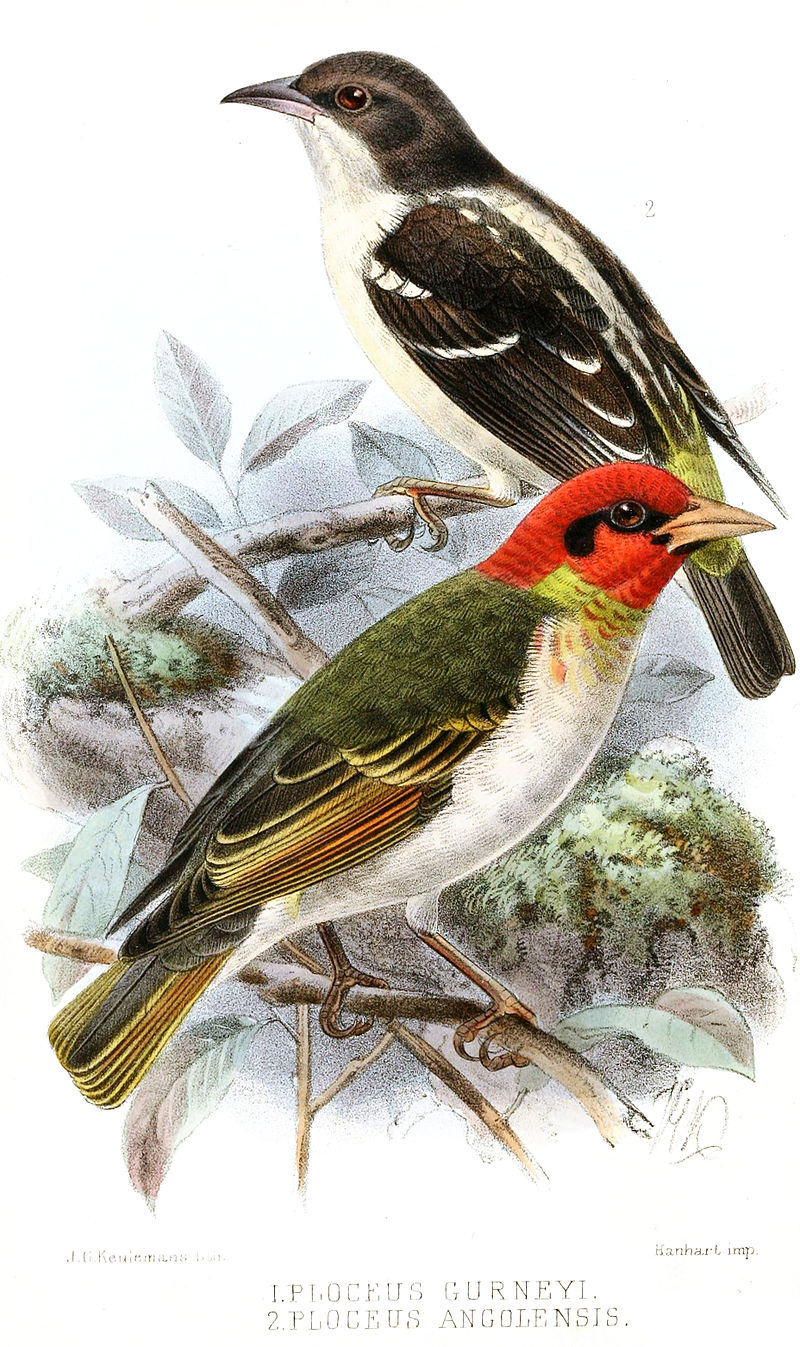
The Bar-winged Weaver is a species of bird belonging to the Ploceidae family. It can be found in Angola, Democratic Republic of the Congo and Zambia. The average length for this type of weaver is 13cm, with dark coloring on its upper body and lighter colorings on its lower half.
Its head has blackish-brown feathers which continue down onto its wings; these also have white tips at their ends adding a unique touch to it’s appearance.
They are omnivorous creatures that feed mainly on insects, but they will also eat seeds when available. Additionally they nest in colonies near grasslands or marshes where there is an abundance of food sources available throughout the year enabling them to survive and thrive no matter what season it may be.Scientific classification:
| Kingdom | Animalia |
| Phylum | Chordata |
| Class | Aves |
| Order | Passeriformes |
| Family | Ploceidae |
| Genus | Ploceus |
| Species | P. angolensis |
33. Red-Necked Spurfowl
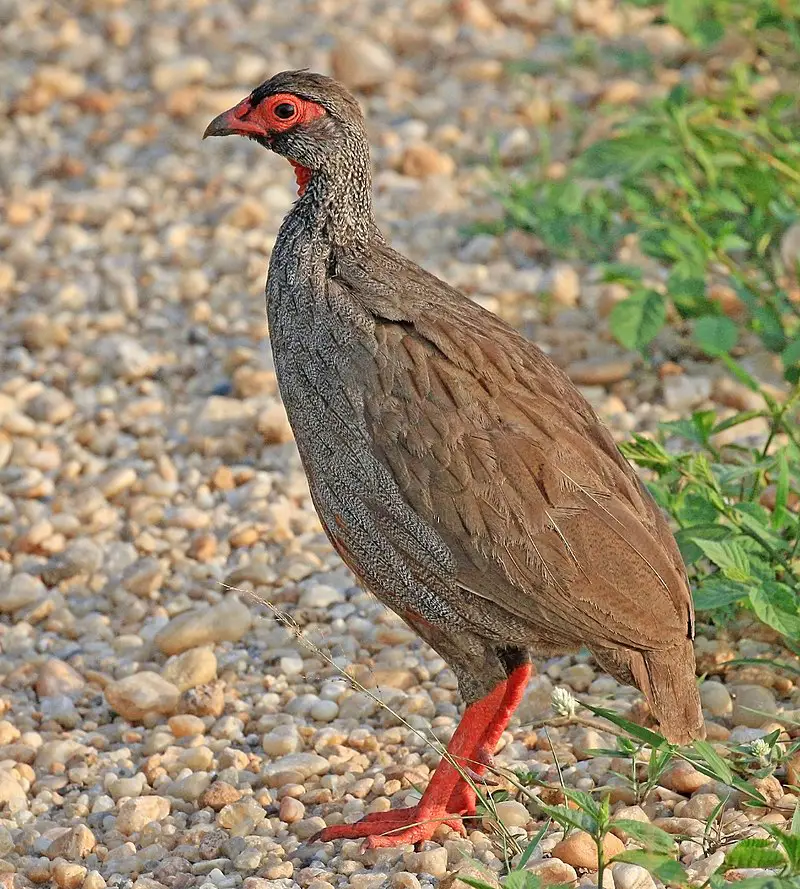
The Red-necked Spurfowl is a gamebird belonging to the pheasant family Phasianidae, and is natively found in southern Africa.
It was first described by German zoologist Philipp Ludwig Statius Müller in 1776 with its type locality being Benguela in western Angola.
This bird has been known for having two distinct colour morphs – greyish or chestnut brown plumage on their back and wings, as well as dark spots near its eyes that are bordered underneath by white stripes.
They also have bright red necks which earned them their name ‘Red-necked’.
These birds can be seen scavenging around human settlements during the day searching for food such as seeds, berries and insects amongst other things like small reptiles.
Despite their small size they are quite capable of defending themselves against predators due to some individuals possessing spurs at the end of each wing joint that act similarly to talons when attacking an enemy.Scientific classification:
| Kingdom | Animalia |
| Phylum | Chordata |
| Class | Aves |
| Order | Galliformes |
| Family | Phasianidae |
| Genus | Pternistis |
| Species | P. afer |
34. Western Banded Snake Eagle
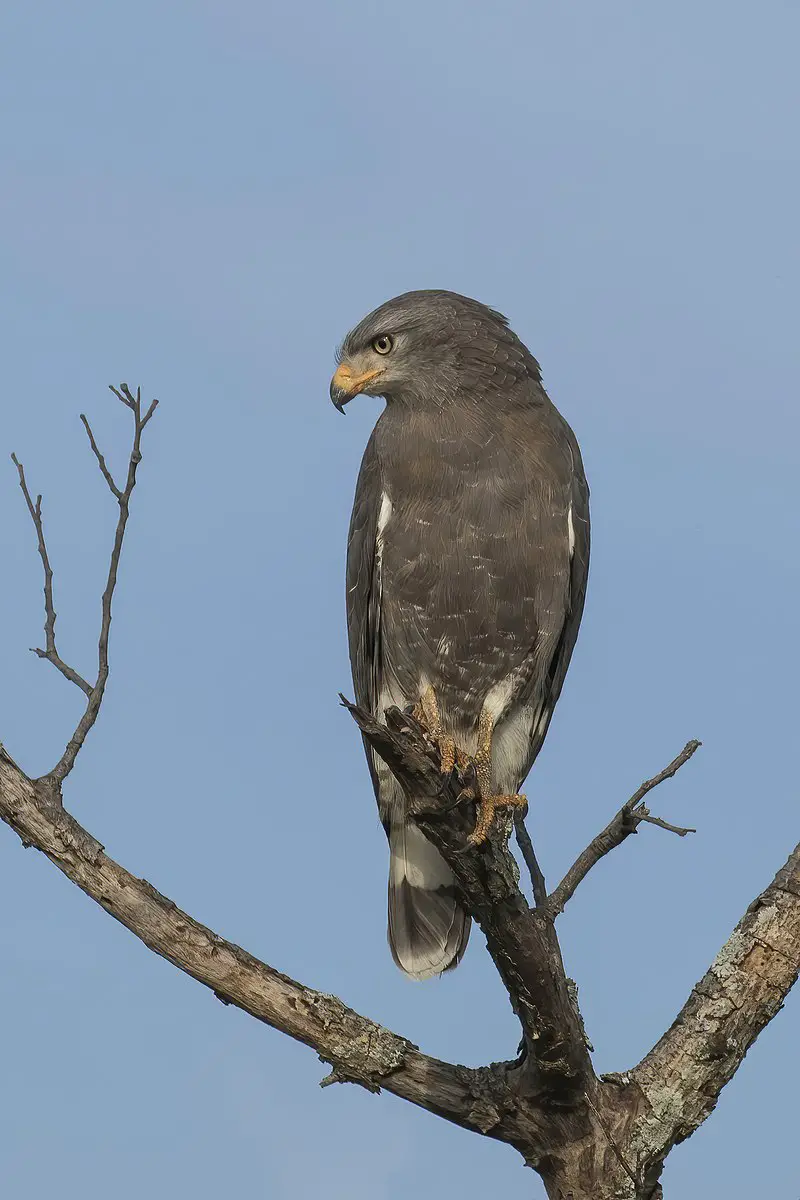
The Western banded snake eagle is a beautiful African raptor, with grey-brown upper parts and white edged feathers. Juveniles have paler and browner colors while adults develop darker hues.
Its head, neck and breast are darkly streaked, offset by its white underparts which feature pale brown streaks on the belly and thighs. Subadults may lack any streaky patterning all together.
These birds mainly live in open woodlands near rivers or lakes where they hunt snakes as well as other small animals like lizards for food. They build nests high up in trees to protect their young from predators – watchful parents indeed.Scientific classification:
| Kingdom | Animalia |
| Phylum | Chordata |
| Class | Aves |
| Order | Accipitriformes |
| Family | Accipitridae |
| Genus | Circaetus |
| Species | C. cinerascens |
35. Stone-Curlew

Stone-curlews, also known as dikkops or thick-knees, are a family of birds that have adapted to live in tropical and temperate regions throughout the world.
They can be found in Africa, Asia and Australia with two or more species per region. Despite being classified as waders, most prefer dry arid habitats over moist wetlands.
Stone-curlews typically have long legs which help them navigate through their preferred terrain efficiently; some species even stand at an impressive height when standing on those long legs.
Additionally they feature cryptic plumage which helps them blend into their surroundings while hunting for prey such as insects and small mammals like rodents.
These unique bird’s calls are easily recognizable; it has been said that hearing one is similar to listening to someone whistling ‘Keee Weee’.Scientific classification:
| Kingdom | Animalia |
| Phylum | Chordata |
| Class | Aves |
| Order | Charadriiformes |
| Suborder | Chionidi |
| Family | Burhinidae Mathews, 1912 |
36. Heliornithidae
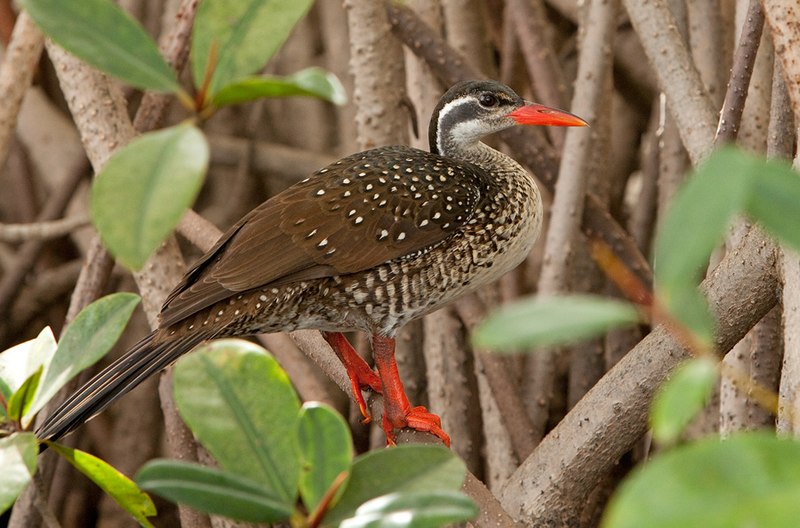
Heliornithidae, commonly known as finfoots, are a small family of tropical birds found in South America and Africa. They have webbed feet like grebes or coots, long necks, slender bodies and broad tails with sharp pointed bills.
Their diverse calls include whistles, squawks and croaks which they use to communicate with each other.
Finfoots feed mainly on fish but also consume insects such as water beetles and dragonflies near the surface of waterbodies.
They nest around rivers or lakes where there is plenty of cover from predators such as eagles or hawks.
During breeding season males can become quite territorial defending their territories against intruders by chasing them off aggressively using loud noises or even physical contact if necessary.Scientific classification:
| Kingdom | Animalia |
| Phylum | Chordata |
| Class | Aves |
| Order | Gruiformes |
| Family | Heliornithidae GR Gray, 1840 |
37. Glareolidae
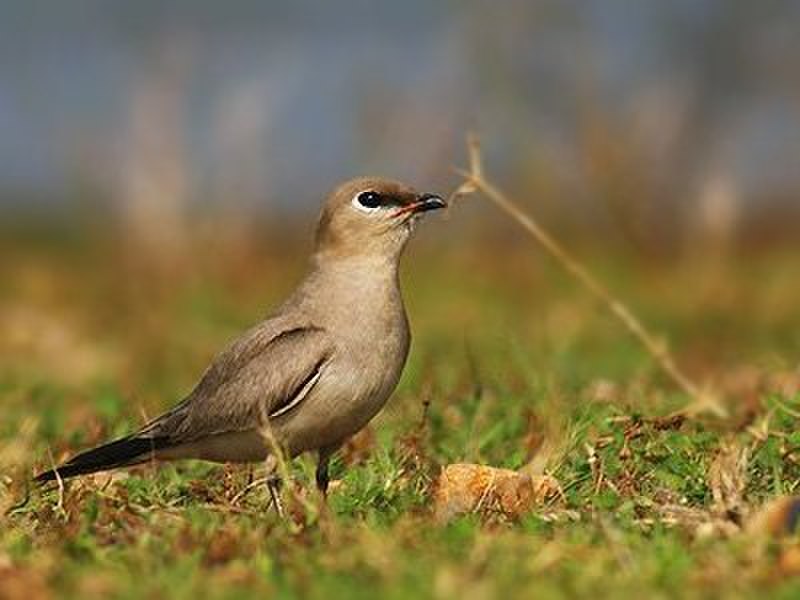
Glareolidae is a family of wading birds, consisting of four genera and 17 species. They are distinguished from other charadrii by their long bills which have a slight downward curve.
Glareolidae live around open grasslands and deserts, where they hunt for insects using the bill to probe into soil or vegetation.
Most species are found in Africa but two pratincoles inhabit parts of Europe and Asia as well.
Coursers tend to be larger than pratincoles with longer legs allowing them to run quickly across sandy dunes while feeding on small animals like lizards or spiders.
Pratincoles feed mainly on flying insects, snatching them out of midair with great agility during flight.
All glareolids share unique features such as large eyes that help it spot prey at night easily making this group one interesting bird family.Scientific classification:
| Kingdom | Animalia |
| Phylum | Chordata |
| Class | Aves |
| Order | Charadriiformes |
| Suborder | Lari |
| Family | Glareolidae CL Brehm, 1831 |
38. Böhm’s Flycatcher
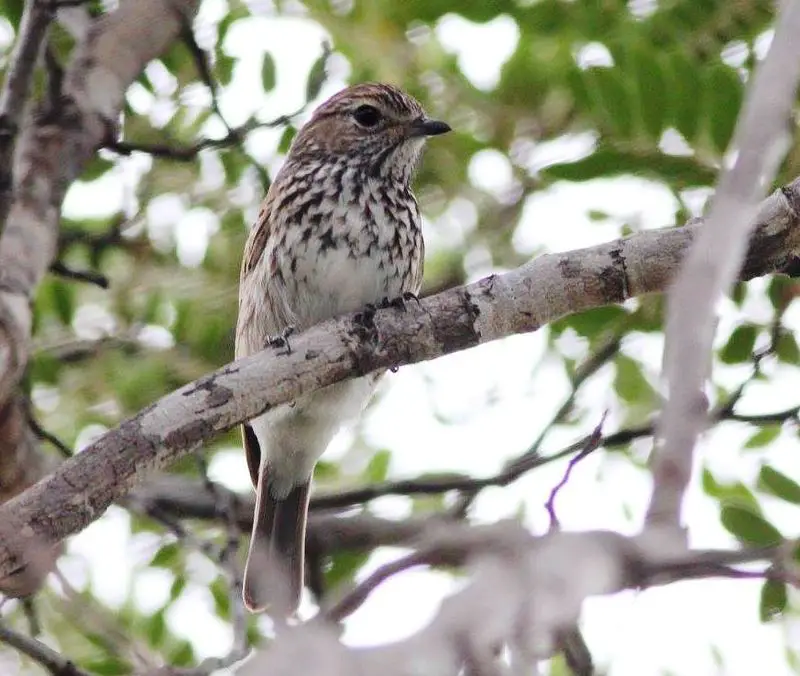
Böhm’s flycatcher is a species of bird that belongs to the Muscicapidae family. It inhabits subtropical or tropical dry forests known as miombo woodlands.
This small passerine bird was named after German zoologist Richard Böhm in recognition for his contributions to the scientific knowledge about this species.
The adult birds have greyish-brown upperparts and white underparts, with two distinct white wing bars and dark tail feathers which form an obvious black band at its tip.
They usually feed on insects like flies, beetles and caterpillars while perched low in trees or hovering above ground level near vegetation cover such as shrubs and vines where they can find their prey easily.
These adaptable little birds are not considered threatened but still need protection from habitat destruction caused by human activities including deforestation, logging, agricultural expansion etc., so that future generations may continue to enjoy them in their natural environment.Scientific classification:
| Kingdom | Animalia |
| Phylum | Chordata |
| Class | Aves |
| Order | Passeriformes |
| Family | Muscicapidae |
| Genus | Muscicapa |
| Species | M. boehmi |
39. African Pied Wagtail
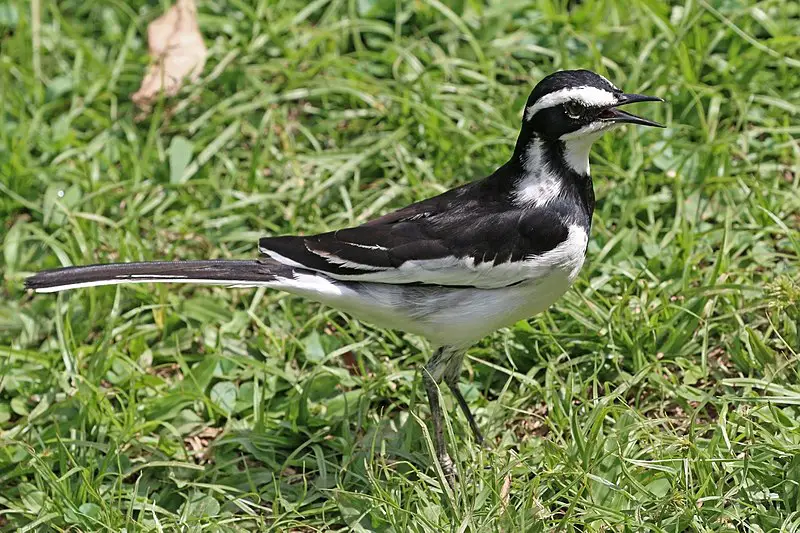
The African pied wagtail is a beautiful bird, with striking black and white feathers. At 20 cm in length it makes an eye-catching sight wherever it goes.
The upperparts of the body are deep black while its underparts are pure white, with a distinctive white supercilium and wing patch when seen at rest.
Juveniles have greyer colors than adults, while birds from the nominate subspecies show grey flanks.
These stunning wagtails can be found near wetlands or on open grassland during migration season but they spend most of their time around streams and rivers throughout Africa where they feed mainly on small insects such as flies, beetles and spiders that live close to water sources.
They may also eat some berries or seeds if available.Scientific classification:
| Kingdom | Animalia |
| Phylum | Chordata |
| Class | Aves |
| Order | Passeriformes |
| Family | Motacillidae |
| Genus | Motacilla |
| Species | M. aguimp |
40. Plovers

Plovers are a family of around 64-68 species of ground-dwelling birds, commonly found in open country such as fields, meadows and tundras.
They have short bills with webbed feet to help them forage through mud or shallow water.
Plover plumage is usually mottled brown though some species may have brighter colors on the head and wings.
These birds feed mainly on insects but can also eat small crustaceans and worms.
Plovers breed during springtime when they dig holes in sandy or pebbled beaches to lay their eggs which hatch after about 3 weeks incubation period.
They use distraction display behaviour by pretending an injury to the predators away from their nests if needed for protecting their young ones.Scientific classification:
| Kingdom | Animalia |
| Phylum | Chordata |
| Class | Aves |
| Order | Charadriiformes |
| Family | Charadriidae Leach, 1820 |
41. Slaty Egret
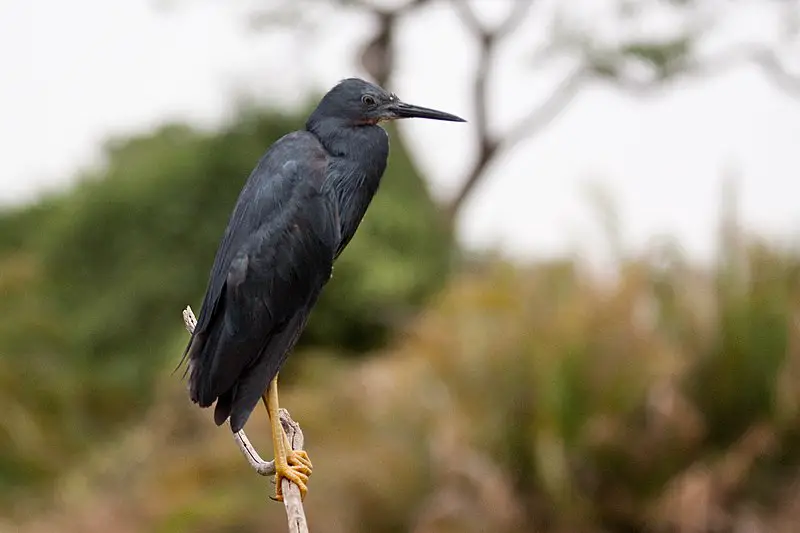
The Slaty Egret is a small, dark species of egret and it is classified as Vulnerable due to the loss of its habitat. It was not until 1971 that it was distinguished from the Black Egret (Egretta ardesiaca), which had previously been thought to be just a colour variation.
This bird has long legs and bill along with yellow eyes and black feet. They are typically found in wetlands such as marshes, swamps or lagoons where they can feed on fish and other aquatic organisms using their bills for spearing prey.
The main threat this species faces is the destruction of habitats due to human activities like urban development or pollution affecting water sources used by these birds for nesting areas or food resources leading them being unable to survive in those places anymore .
Conservation efforts have been made under AEWA agreement aiming at restoring suitable habitats so that populations can recover againScientific classification:
| Kingdom | Animalia |
| Phylum | Chordata |
| Class | Aves |
| Order | Pelecaniformes |
| Family | Ardeidae |
| Genus | Egretta |
| Species | E. vinaceigula |
42. Schalow’s Turaco
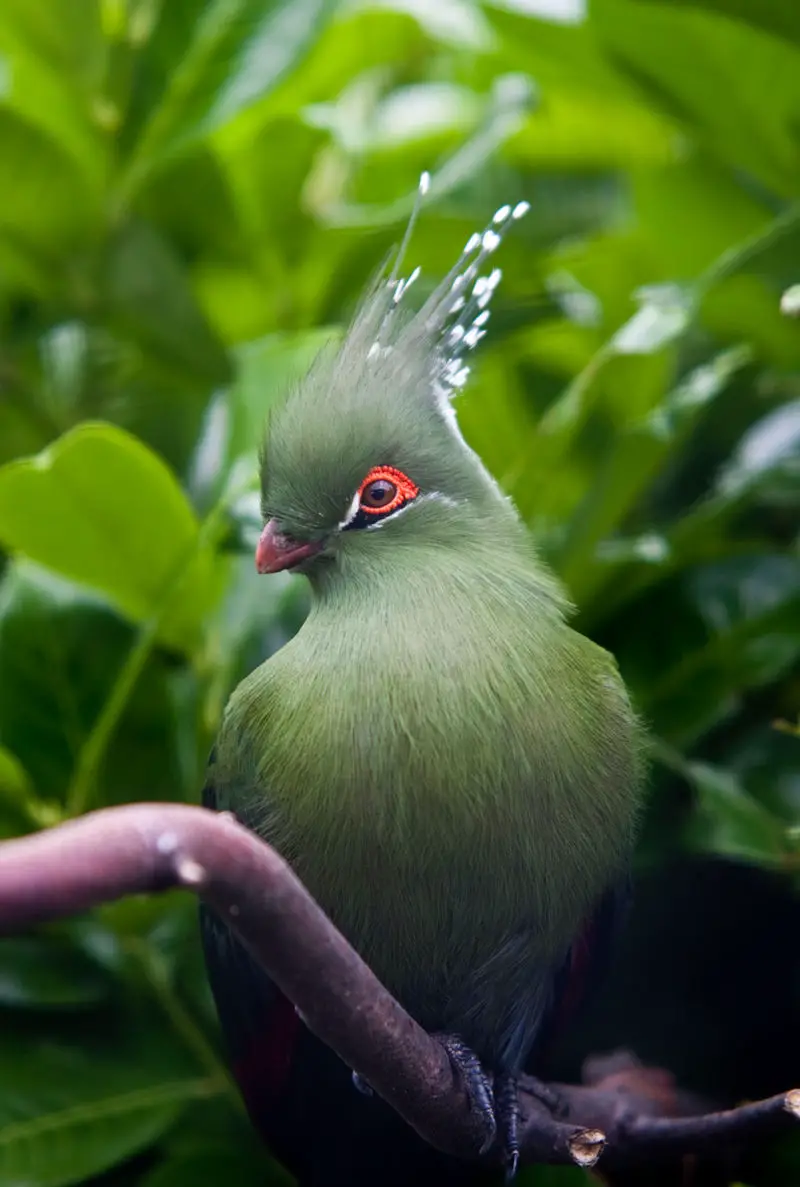
Schalow’s turaco is a vibrant, medium-sized bird native to the western part of Central Africa. Named after German banker and ornithologist Herman Schalow, these birds are renowned for their coppery-jade green plumage which fades into a deep iridescent blue towards the tail.
They’re light for their species, usually weighing around 270g with lengths ranging from 15 to 17 inches. These frugivorous birds mainly feed on fruits like figs and berries as well as flowers and insects in some cases.
In addition to being colorful creatures, they have bright yellow eyes that contrast beautifully with its feathers.
Although not common in aviculture due to difficulties breeding them in captivity (as little is known about this species), they can still be found living wild throughout Cameroon, Gabon and Equatorial Guinea – making them quite an interesting sight if you’re lucky enough to spot one.Scientific classification:
| Kingdom | Animalia |
| Phylum | Chordata |
| Class | Aves |
| Order | Musophagiformes |
| Family | Musophagidae |
| Genus | Tauraco |
| Species | T. schalowi |
43. Painted-Snipe
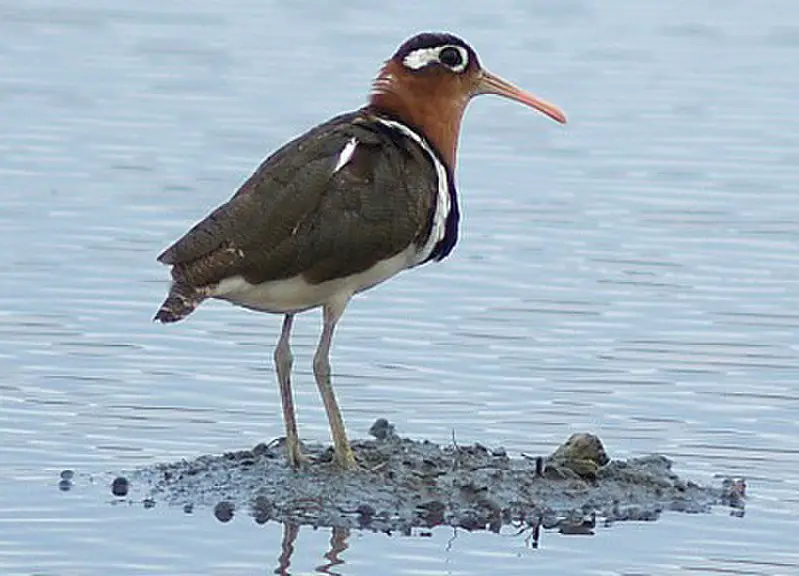
Painted snipes are beautiful and unique wading birds found in the Rostratulidae family. They have short legs, long bills, and a striking plumage which distinguishes them from true snipes.
Males tend to be smaller than females with duller overall coloration. There are three species of painted snipe.
The Greater Painted Snipe, Lesser Painted Snipe, and Australian Painted Snipe – all three have different habitats ranging from wetland pools to grasslands or mangroves depending on their region.
These birds feed mainly on earthworms but also consume insects, crustaceans and plant material when available.
As they rely heavily on wetlands for breeding purposes it is important that we protect these precious habitats so that this special bird can continue to thrive.Scientific classification:
| Kingdom | Animalia |
| Phylum | Chordata |
| Class | Aves |
| Order | Charadriiformes |
| Suborder | Thinocori |
| Family | Rostratulidae Coues, 1888 |
44. Mousebird
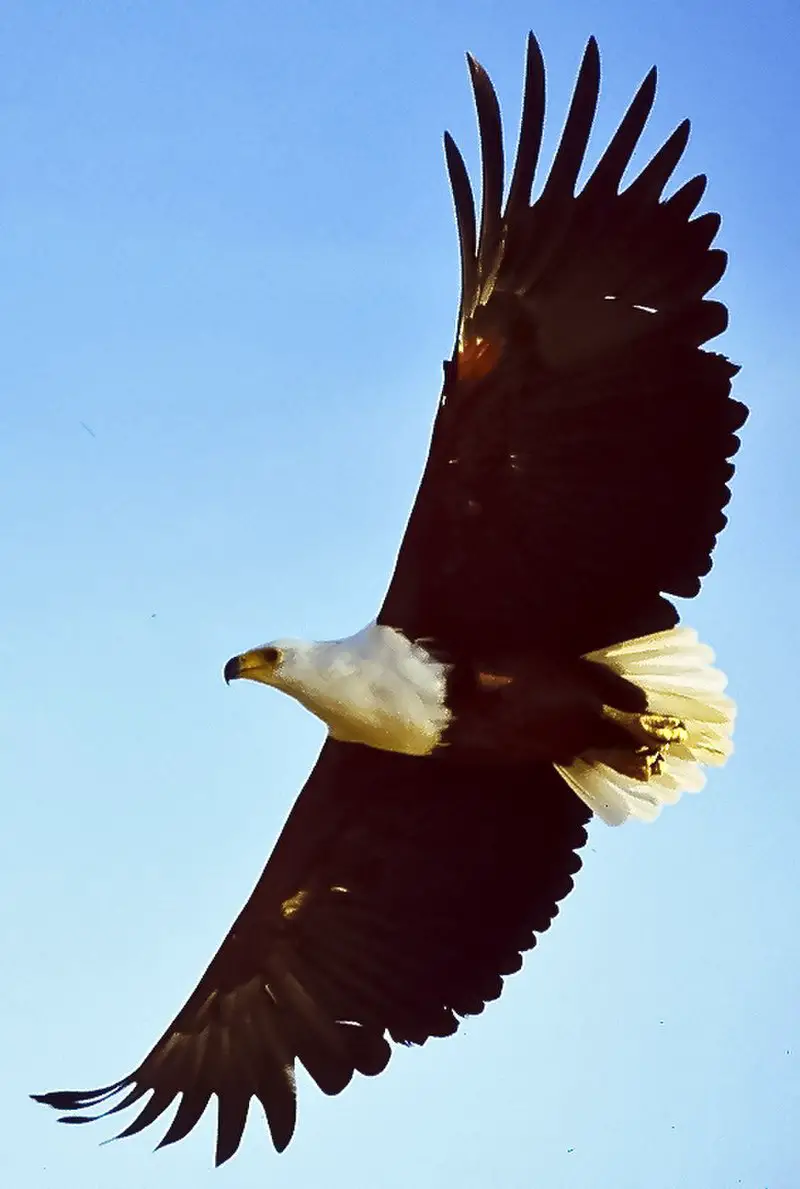
Mousebirds are small, stocky birds found in Africa and the Middle East. They have a long tail with broad black-and-white stripes. Mousebirds get their name from their mouse-like scurrying behavior as they move around on branches and hop across the ground looking for food.
Their diet consists of fruits, buds, leaves, nectar and insects. They typically live in flocks of up to 30 individuals but will gather together during migration or when there is an abundance of food available. The male mousebird performs elaborate courtship displays which involve hopping around quickly while singing loudly before landing on a branch near his chosen mate where he continues to sing until she accepts him as her partner.
After mating has taken place both parents work together to build a large nest made out of twigs and grasses high up in trees or bushes so that it’s safe from predators such as snakes or wild cats below them.
45. Honeyguide
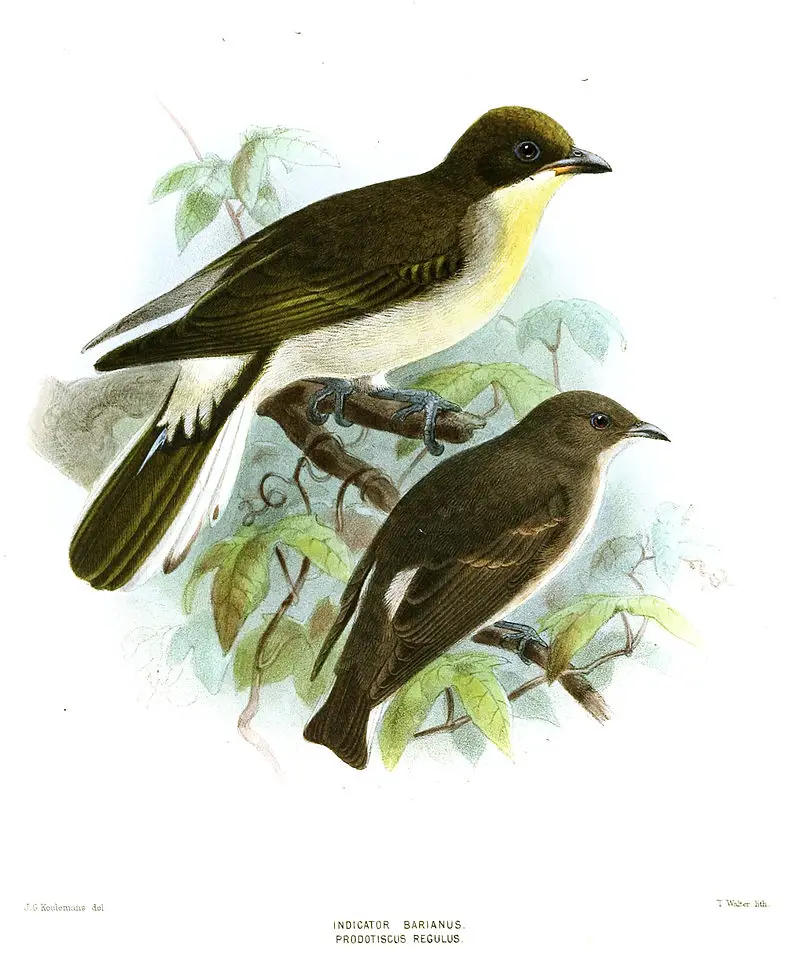
Honeyguides are small, near passerine birds belonging to the family Indicatoridae. Native to tropical regions of Asia and Africa, they’re best known for their unique relationship with humans.
They have a mutualistic association with people by leading them towards bee colonies in exchange for wax or honey from the hive after it has been opened up.
Honeyguide birds use special calls that sound like ‘tink-tink’ or ‘hweet hwuit’, which is thought to be their way of telling potential partners about food sources available nearby.
This remarkable ability makes them an invaluable resource for local communities and indigenous groups who rely on wild bees as a source of income and nutrition.Scientific classification:
| Kingdom | Animalia |
| Phylum | Chordata |
| Class | Aves |
| Order | Piciformes |
| Infraorder | Picides |
| Family | Indicatoridae Swainson, 1837 |
Also Featured In: Native Birds of Equatorial Guinea,
46. Eurasian Reed Warbler
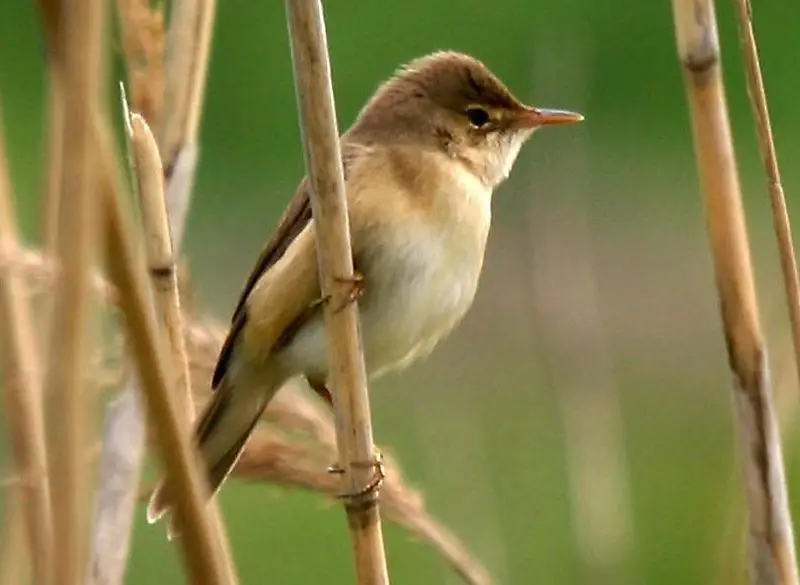
The Eurasian reed warbler (Acrocephalus scirpaceus) is a species of Old World Warbler native to the temperate parts of Europe and Asia.
It breeds in wetlands such as marshes, ponds and rivers with dense vegetation like reeds or tall grasses.
During its wintering season, it migrates southward to sub-Saharan Africa where there are milder conditions.
This small bird has streaked brown plumage on the upperparts and white underparts which makes it difficult for predators to spot among the foliage.
Its diet consists mainly of insects including aphids, caterpillars larvae and moths caught while flying over water or by gleaning from plants growing near water bodies.
The male sings an attractive song consisting of several phrases repeated one after another as part of their courtship display during breeding season in order attract females for mating purposes.Scientific classification:
| Kingdom | Animalia |
| Phylum | Chordata |
| Class | Aves |
| Order | Passeriformes |
| Family | Acrocephalidae |
| Genus | Acrocephalus |
| Species | A. scirpaceus |
47. Common Waxbill
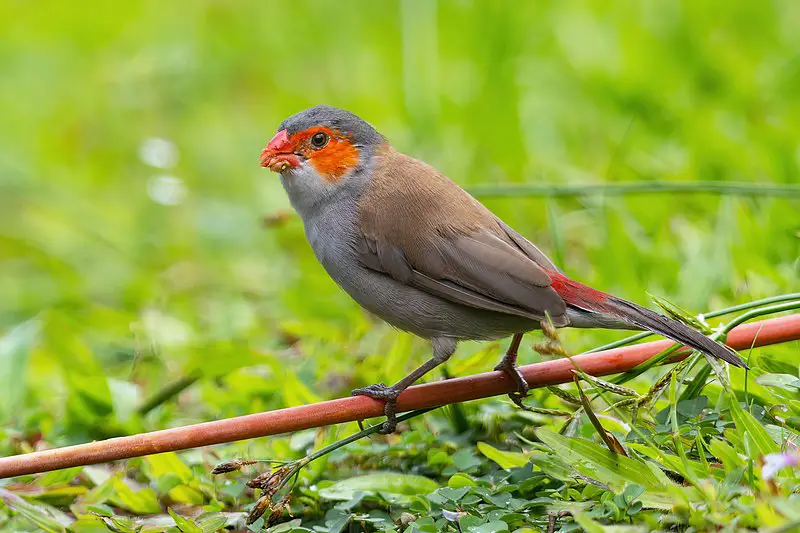
The Common Waxbill is a beautiful small passerine bird native to sub-Saharan Africa.
It has become popular in captivity and can be found all over the world, with an estimated global extent of occurrence of 10 million km2.
Its formal description was provided by Carl Linnaeus in 1758 as part of his Systema Naturae; he gave it the scientific name Estrilda astrild.
This species is mainly greyish brown or olive green on its upperparts while having chestnut colored wings and tail feathers which are tipped with white or creamy yellow.
They have red eyes, pink bills and legs, giving them an overall attractive appearance.
The Common waxbill feeds primarily on grass seeds but also takes insects occasionally when available. It breeds readily in aviaries making it a great choice for avid bird keepers.Scientific classification:
| Kingdom | Animalia |
| Phylum | Chordata |
| Class | Aves |
| Order | Passeriformes |
| Family | Estrildidae |
| Genus | Estrilda |
| Species | E. astrild |
Also Featured In: Most Common Oahu Birds, Martinique Island Birds You Should Know
48. Northern Carmine Bee-Eater
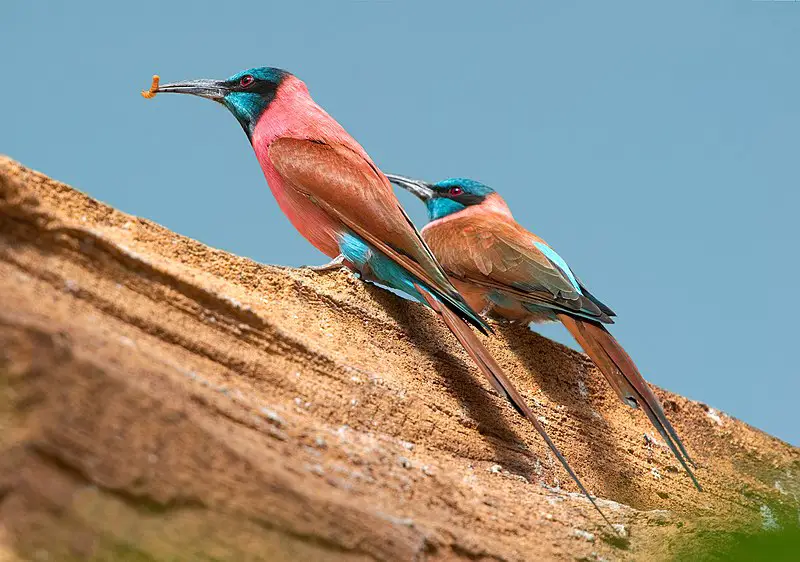
The Northern Carmine Bee-eater is a beautiful bird with striking colors. It has bright red and blue plumage, with the throat being predominantly carmine in color.
This species of bee-eater can be found throughout northern tropical Africa, from Senegal east to Somalia, Ethiopia and Kenya.
It was previously assumed to be closely related to the Southern Carmine Bee-eater which has a scarlet colored throat instead of blue as seen in this species.
The Northern Carmine Bee-Eater feeds on flying insects such as bees and other small creatures that it catches midair using its sharp claws and bill for grabbing them quickly before they escape.Scientific classification:
| Kingdom | Animalia |
| Phylum | Chordata |
| Class | Aves |
| Order | Coraciiformes |
| Family | Meropidae |
| Genus | Merops |
| Species | M. nubicus |
49. Lybiidae
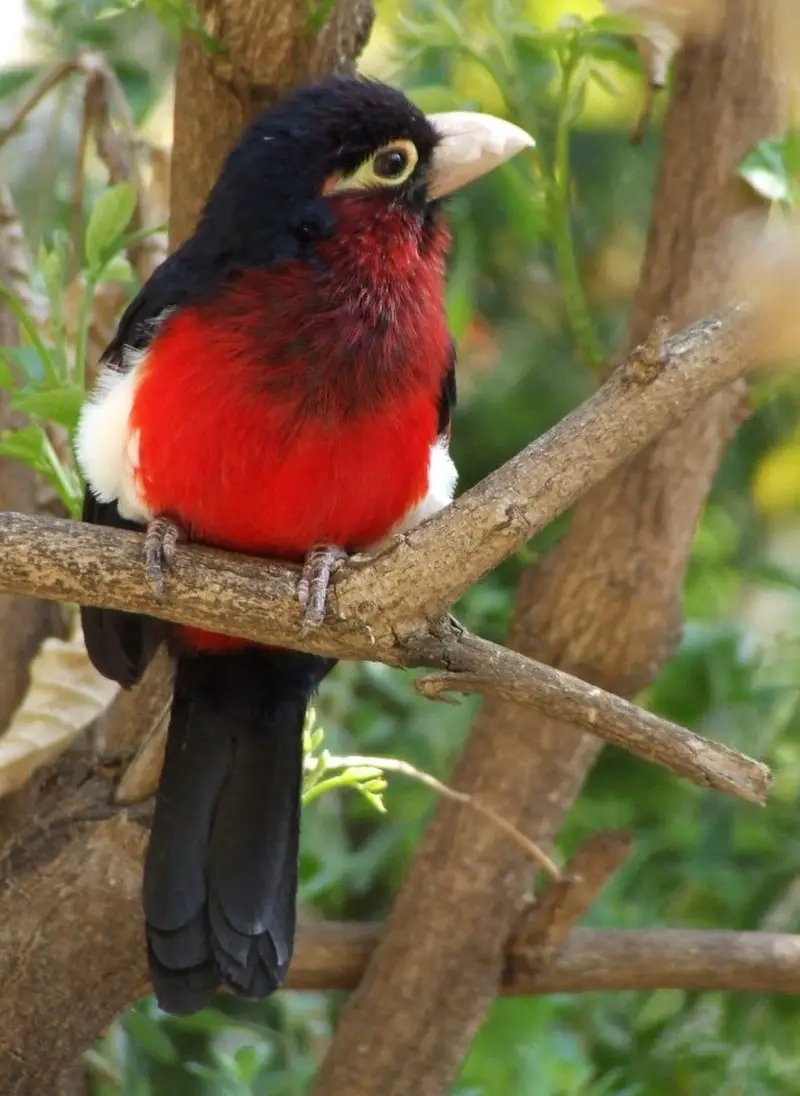
African barbets, belonging to the family Lybiidae, are a large group of birds found throughout sub-Saharan Africa.
They come in different sizes and inhabit various habitats from forests interiors to scrublands.
The Trachyphoninae species live mainly in the southern Sahara desert up until South Africa.
These colourful birds have distinctive features such as their short neck and stout bill that is used for cracking open hard nuts or drilling into tree bark for food.
Some African barbet species are important pollinators of flowers due to their diet consisting mostly on fruits and nectar which forces them to visit many plants daily.
Their bright calls can be heard throughout the day making them easily recognisable by humans too.Scientific classification:
| Kingdom | Animalia |
| Phylum | Chordata |
| Class | Aves |
| Order | Piciformes |
| Infraorder | Ramphastides |
| Family | Lybiidae Sibley & Ahlquist, 1985 |